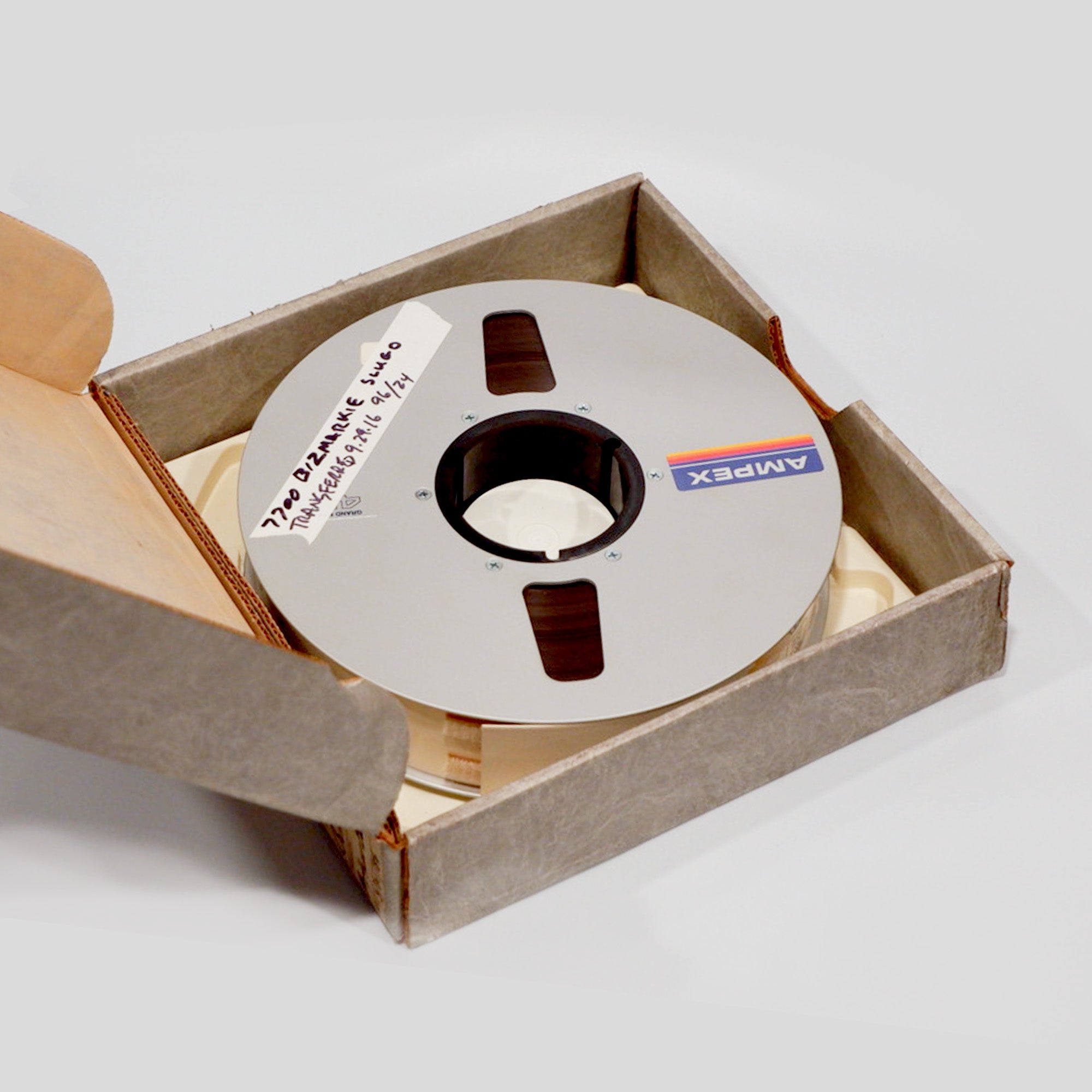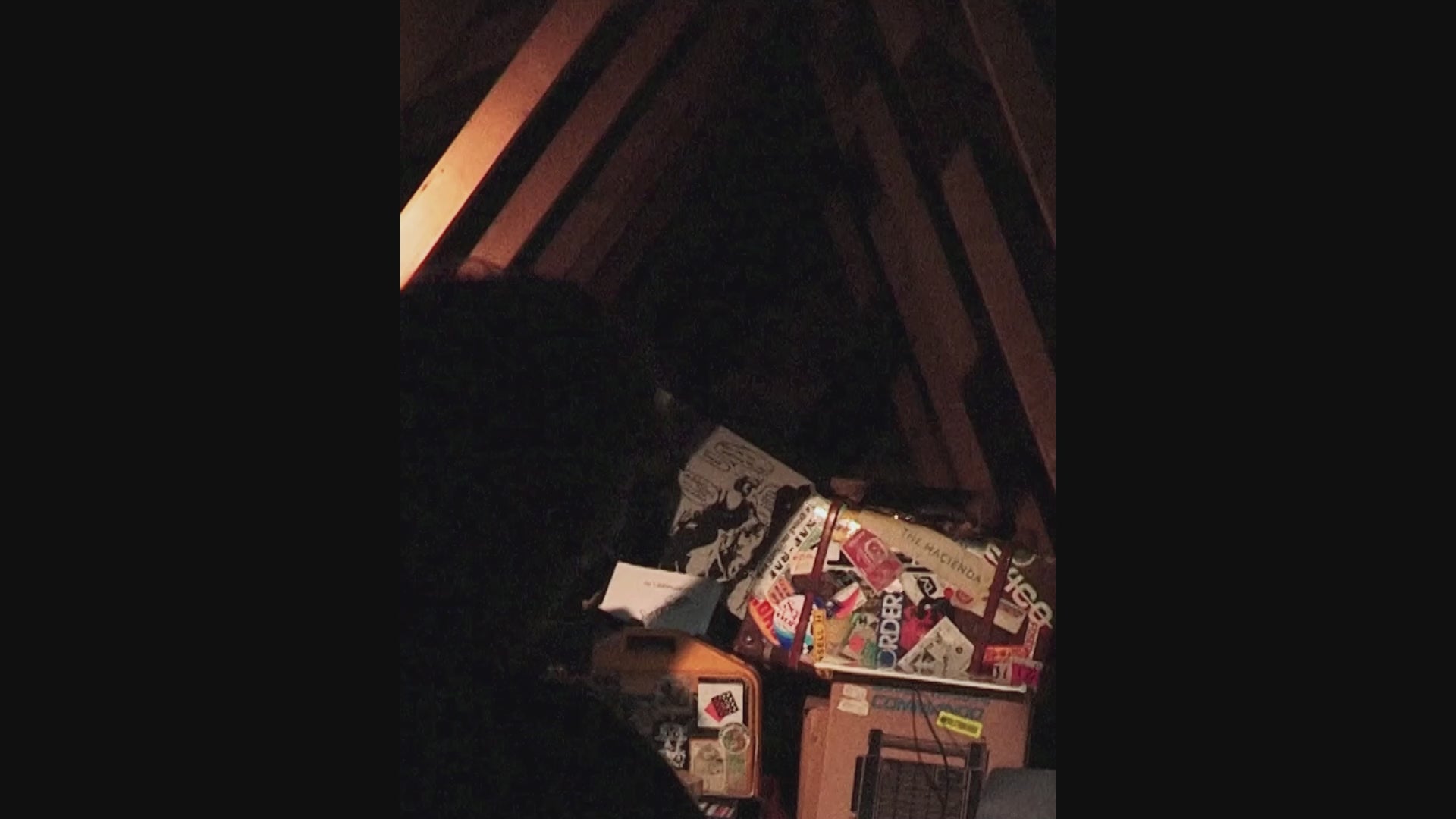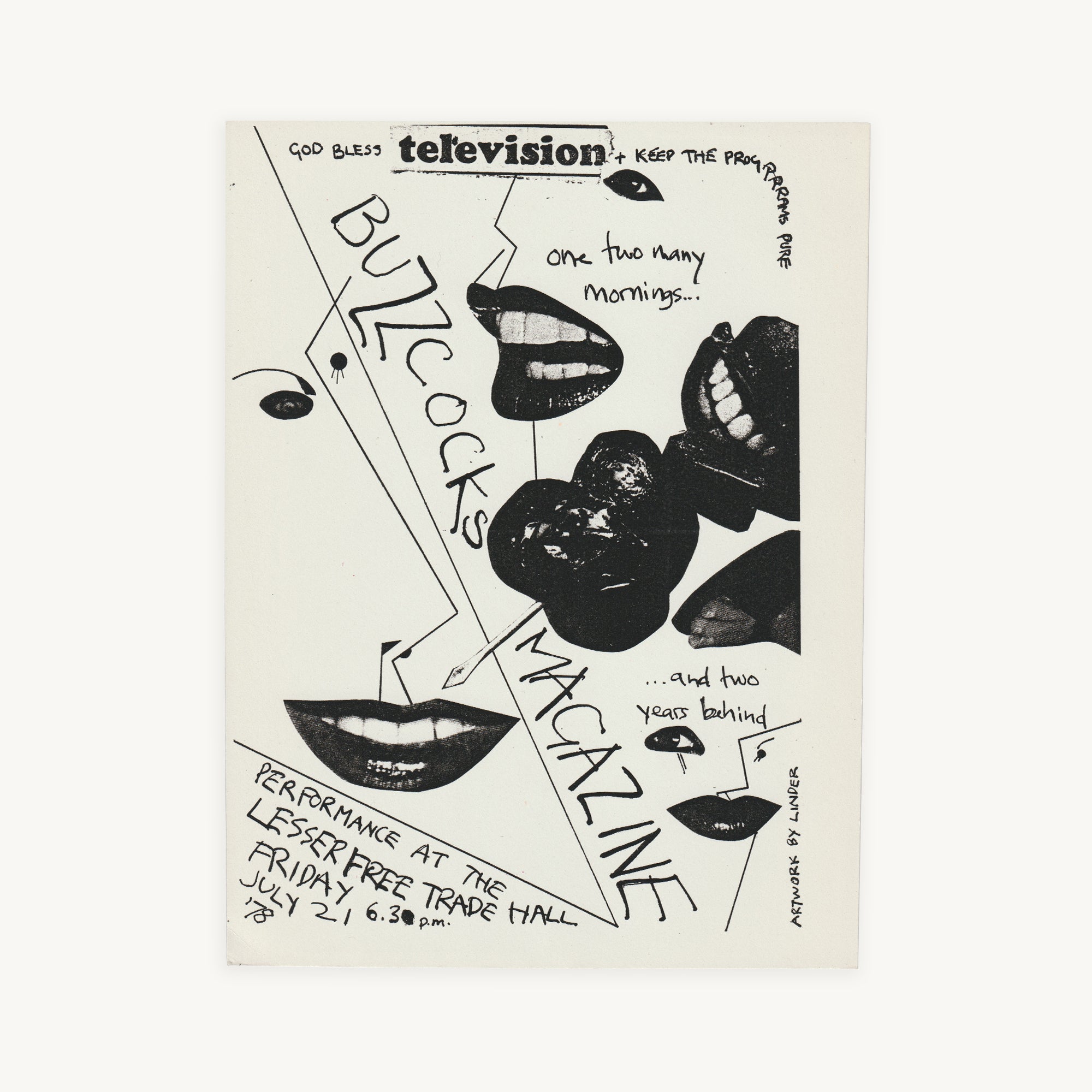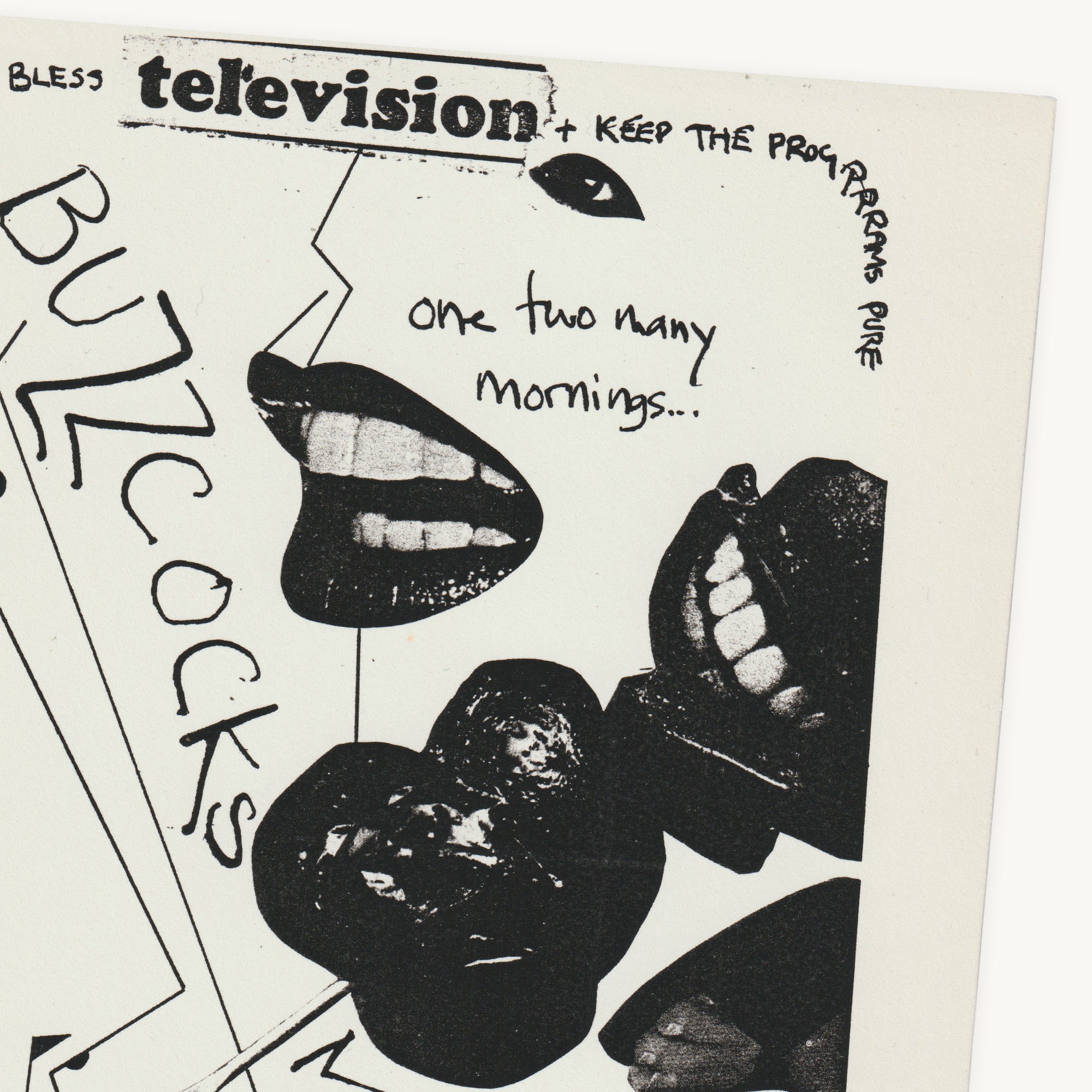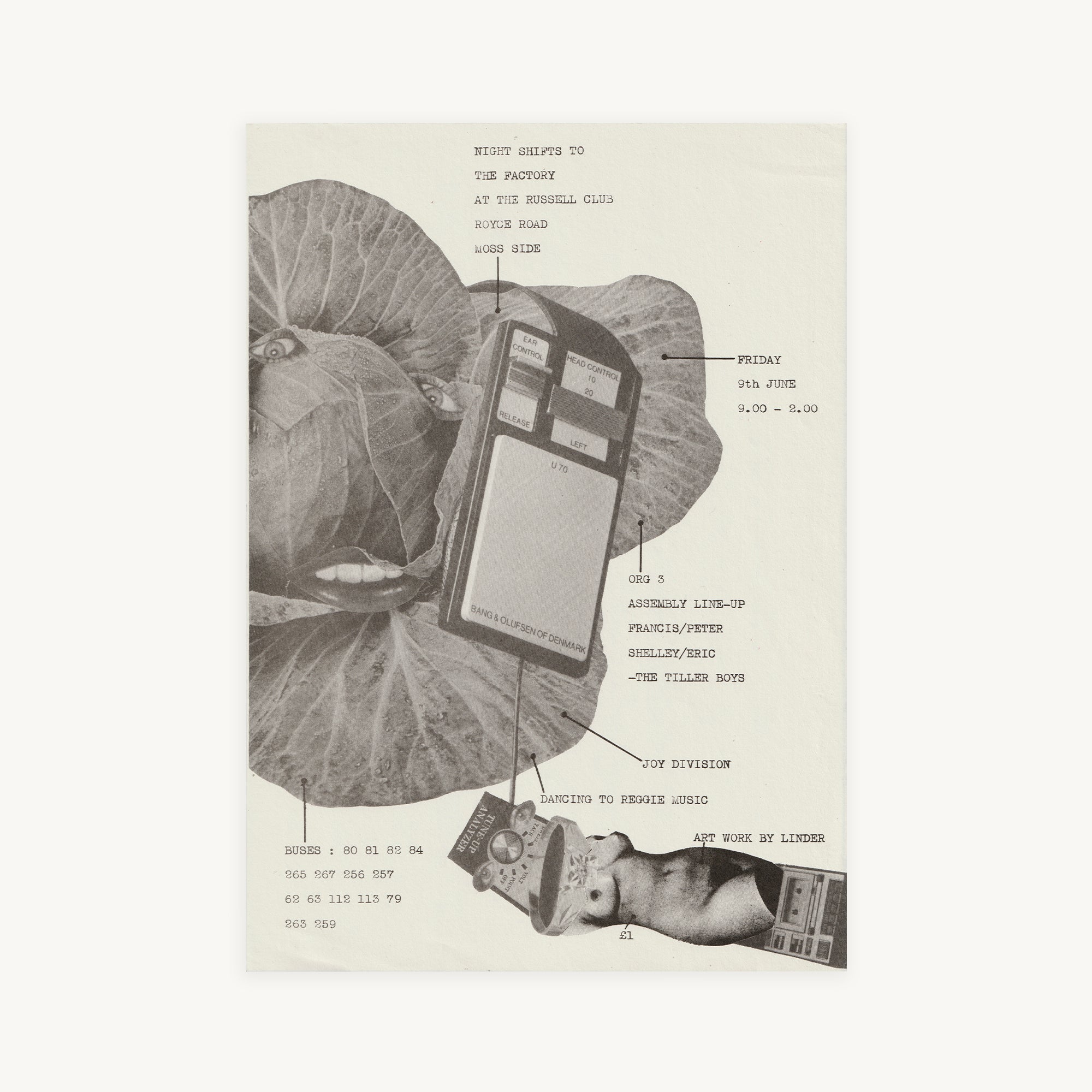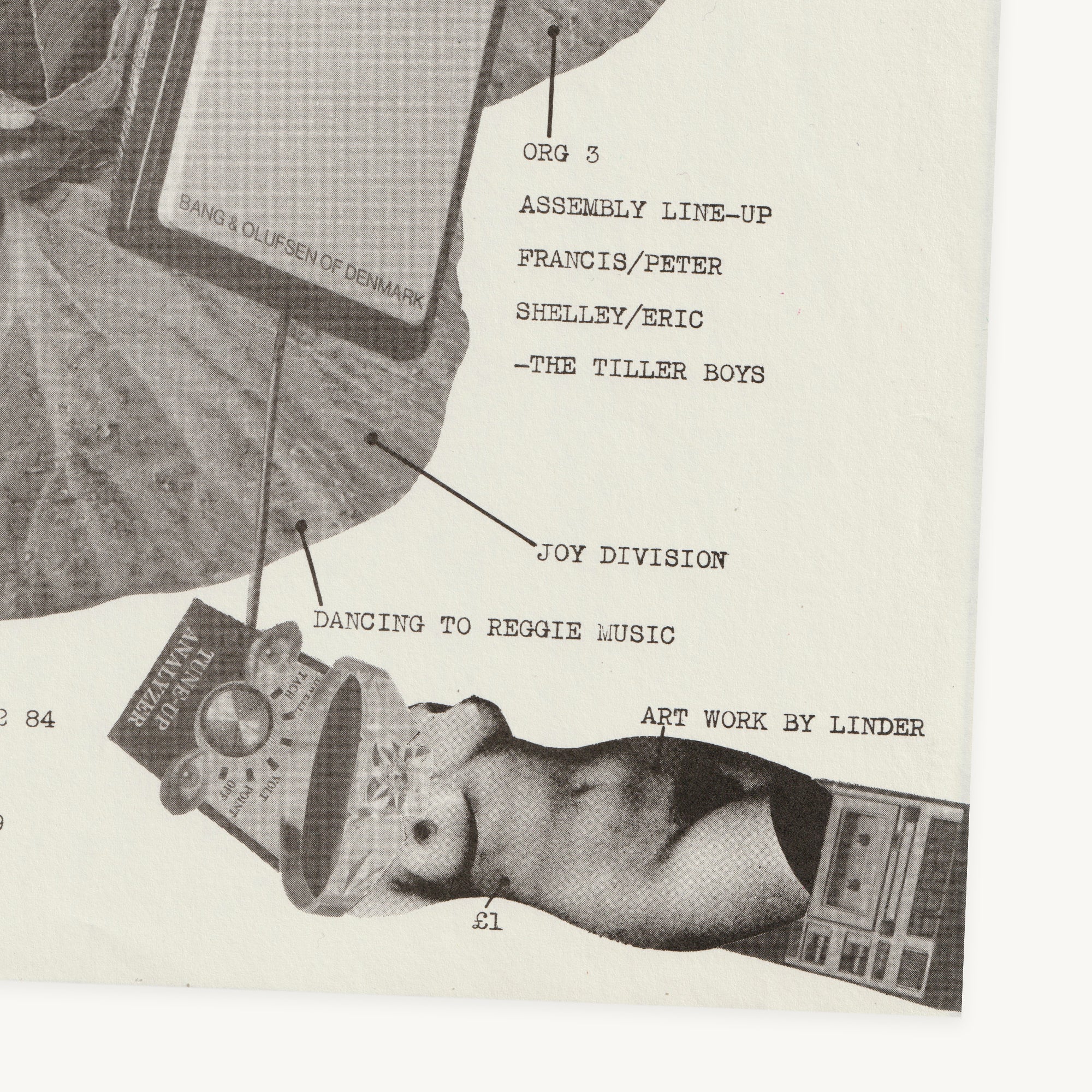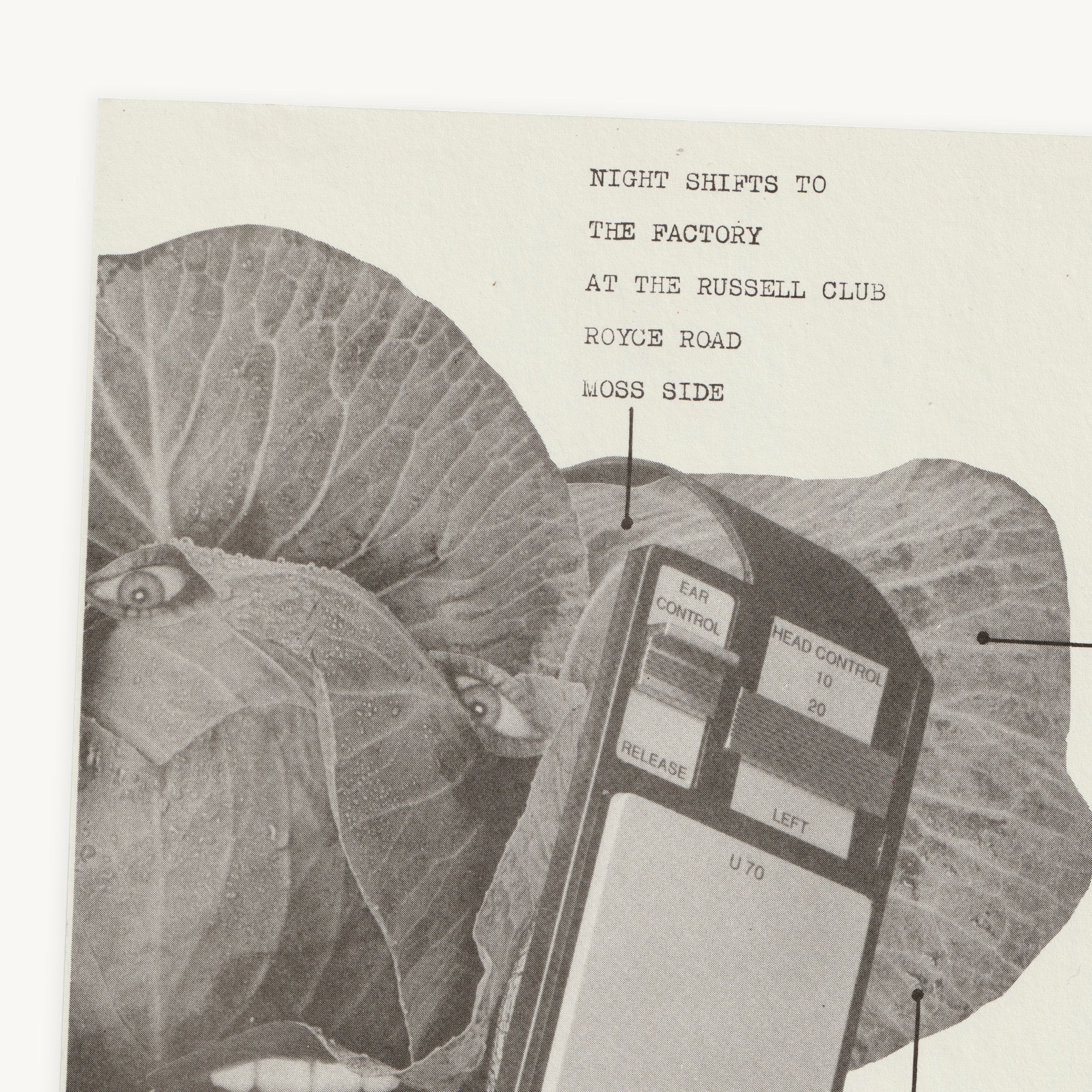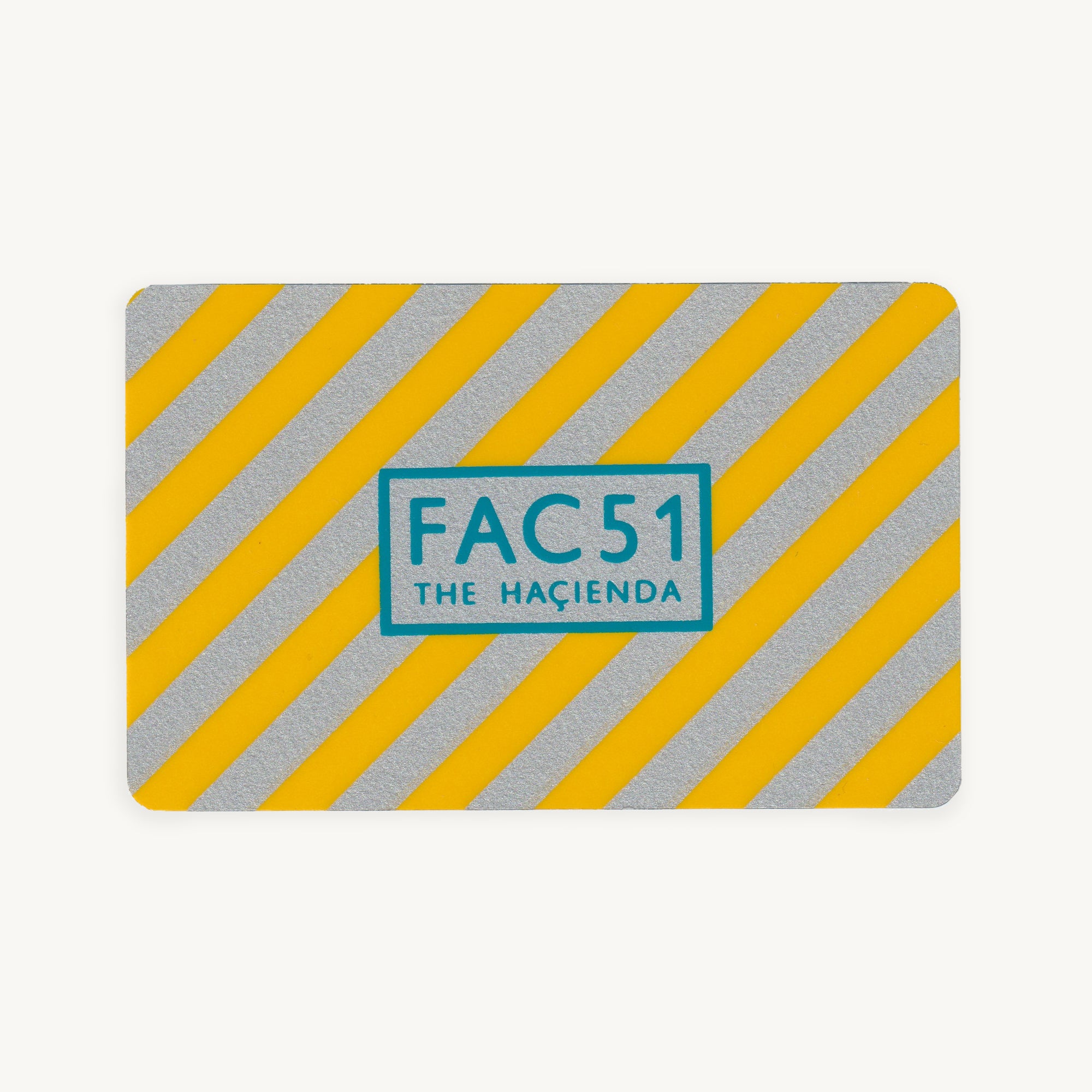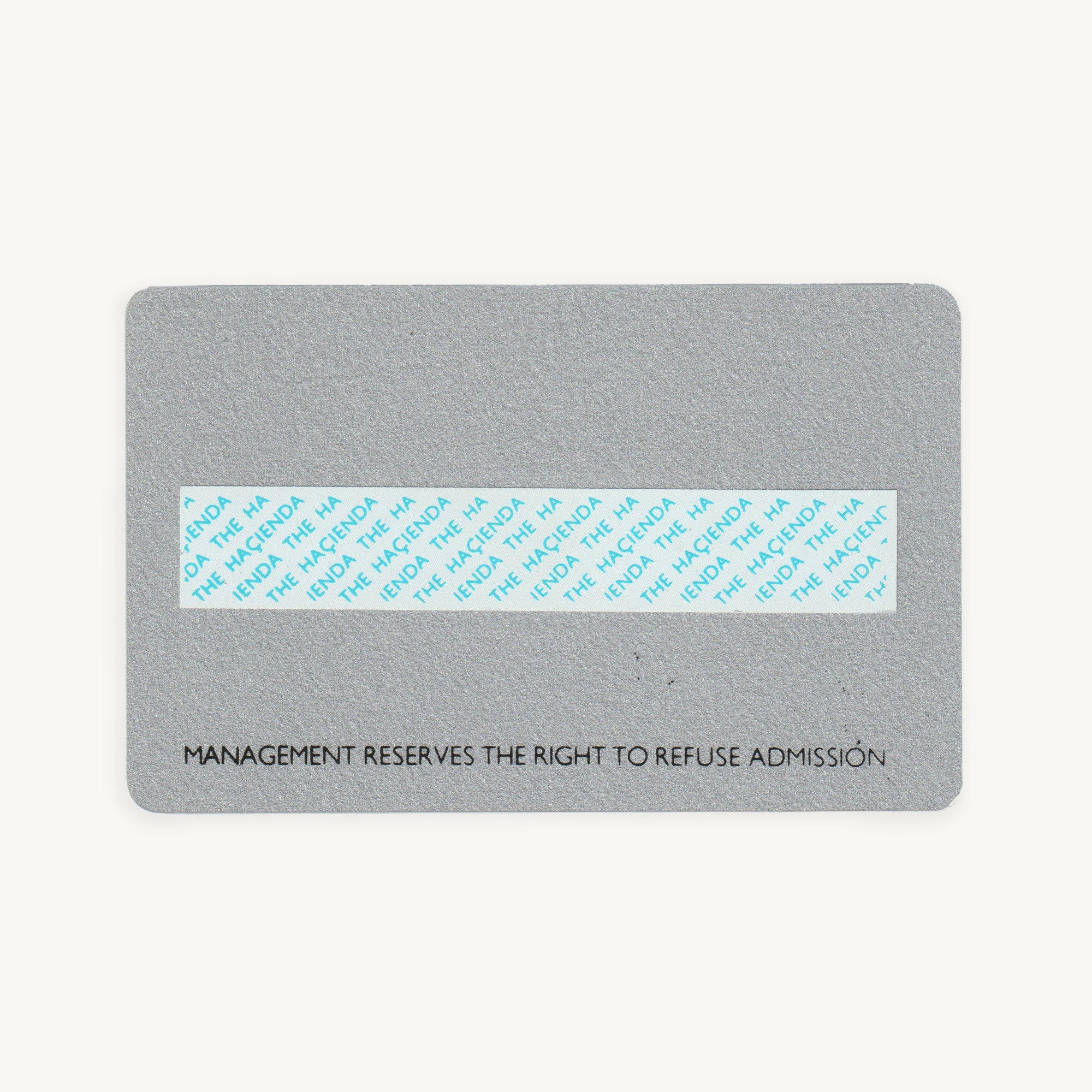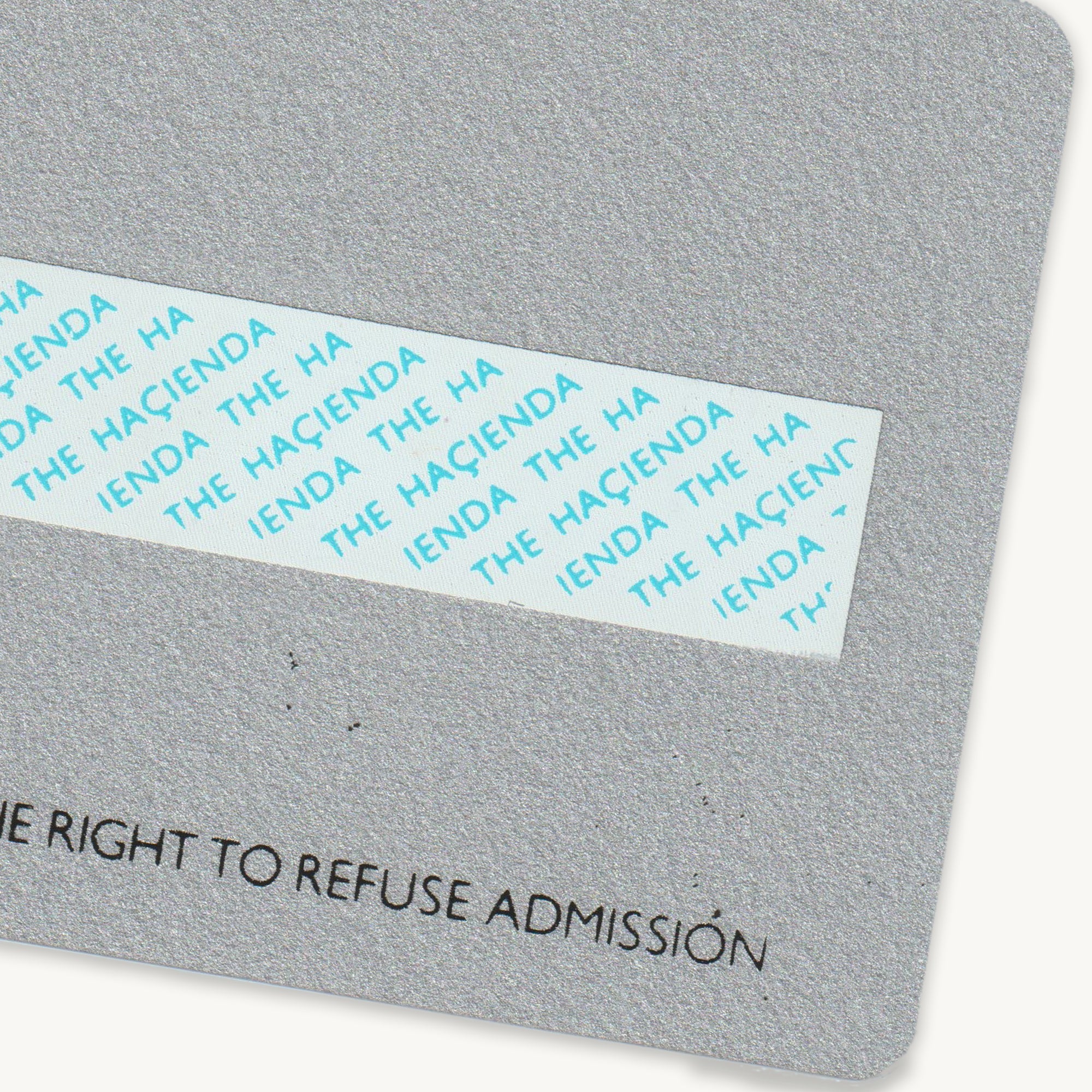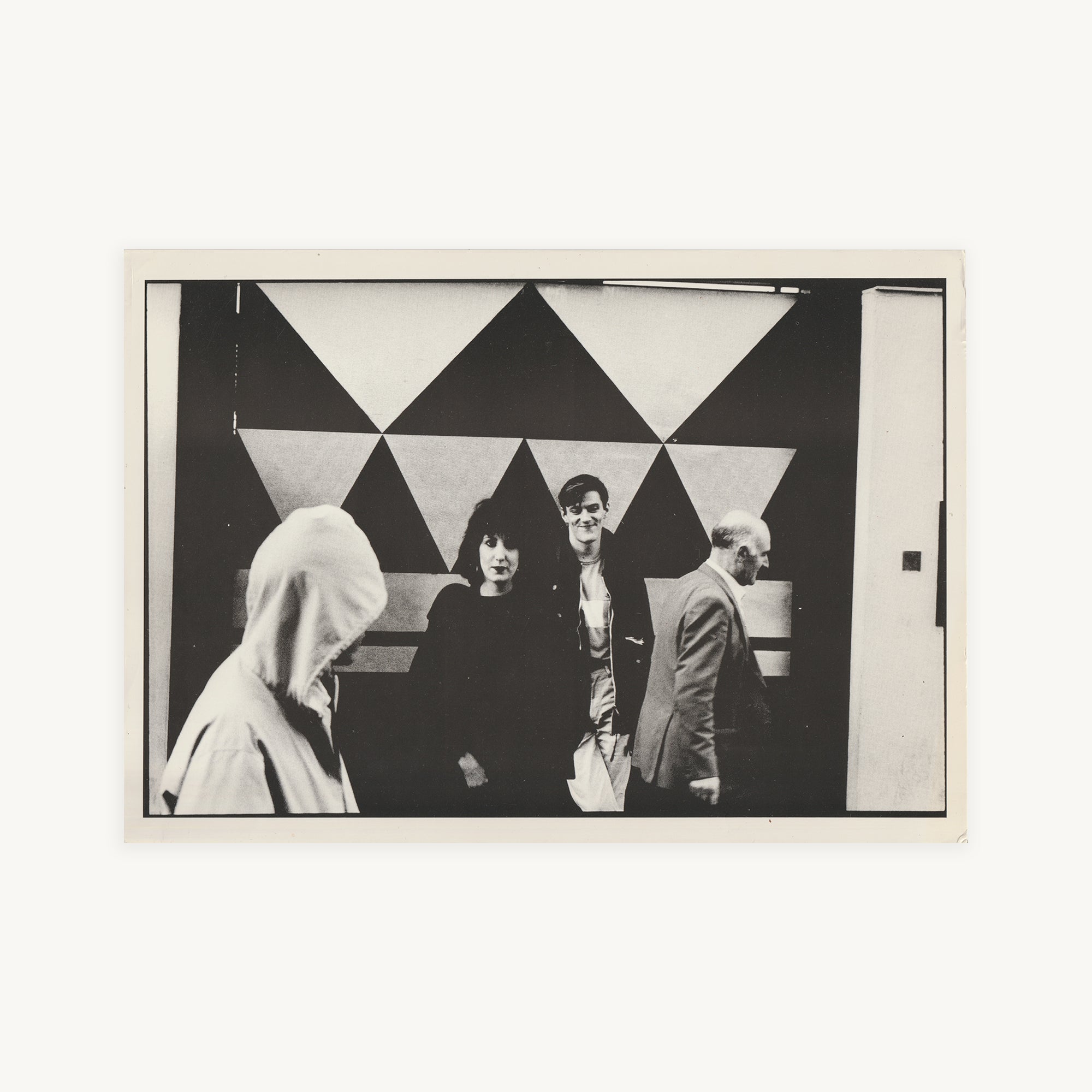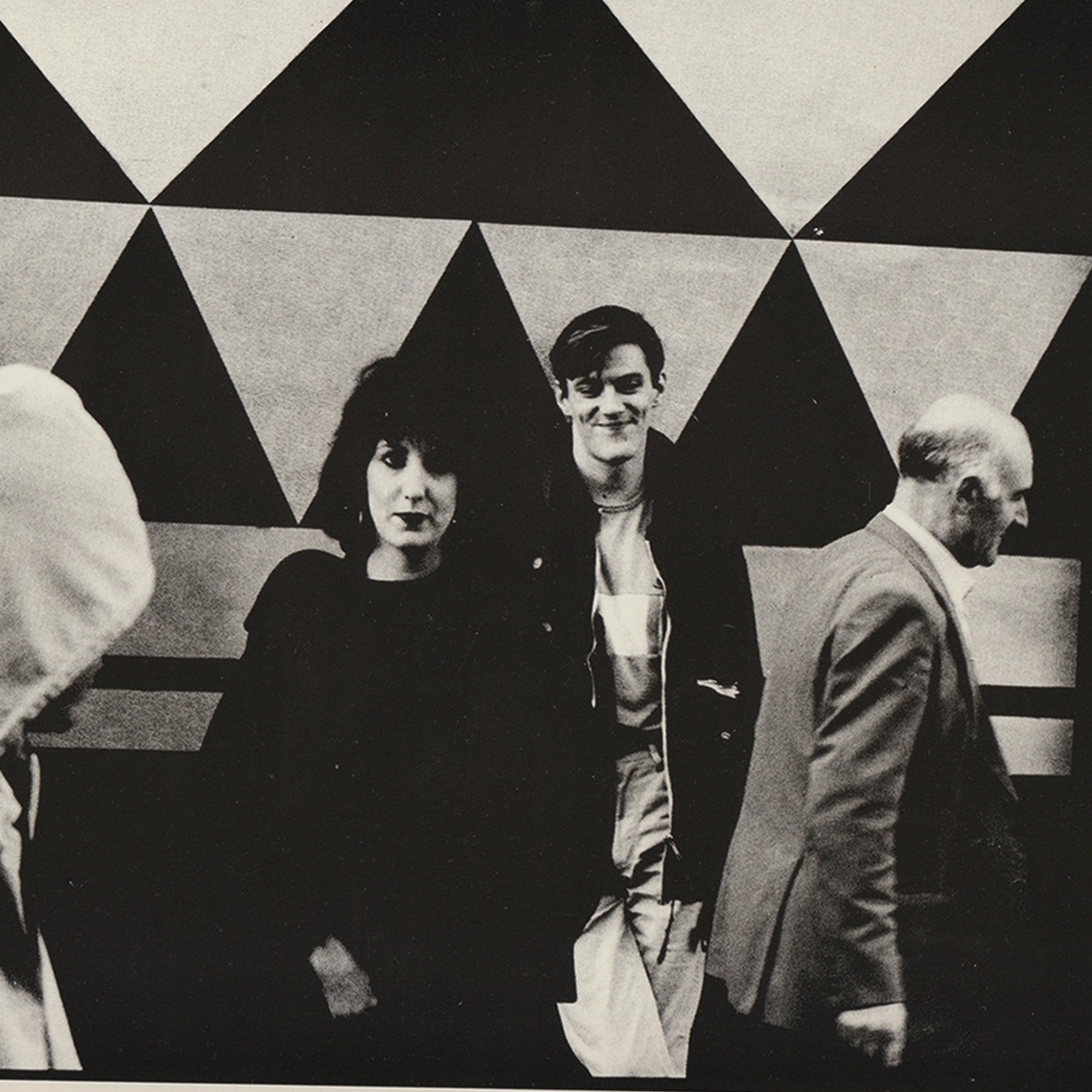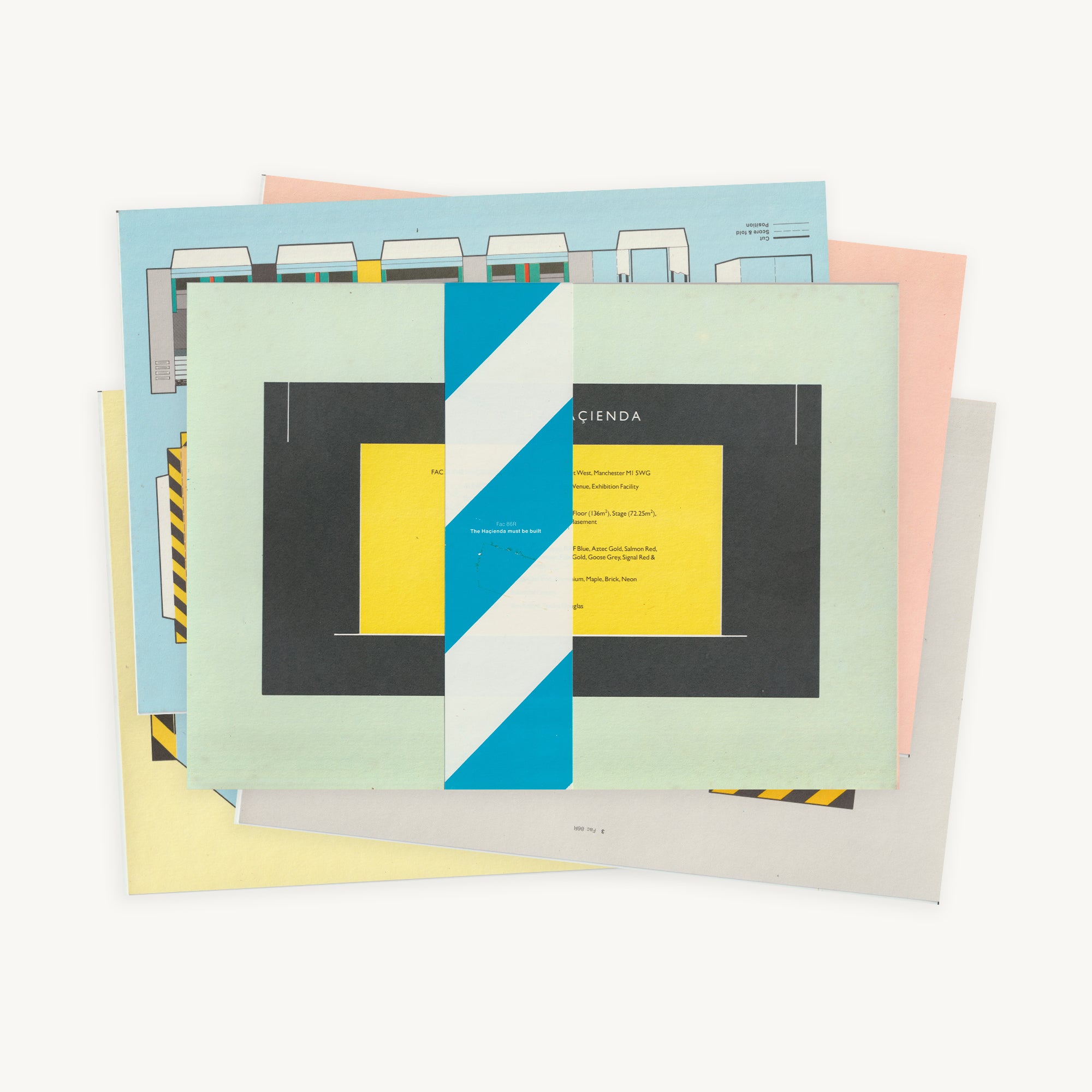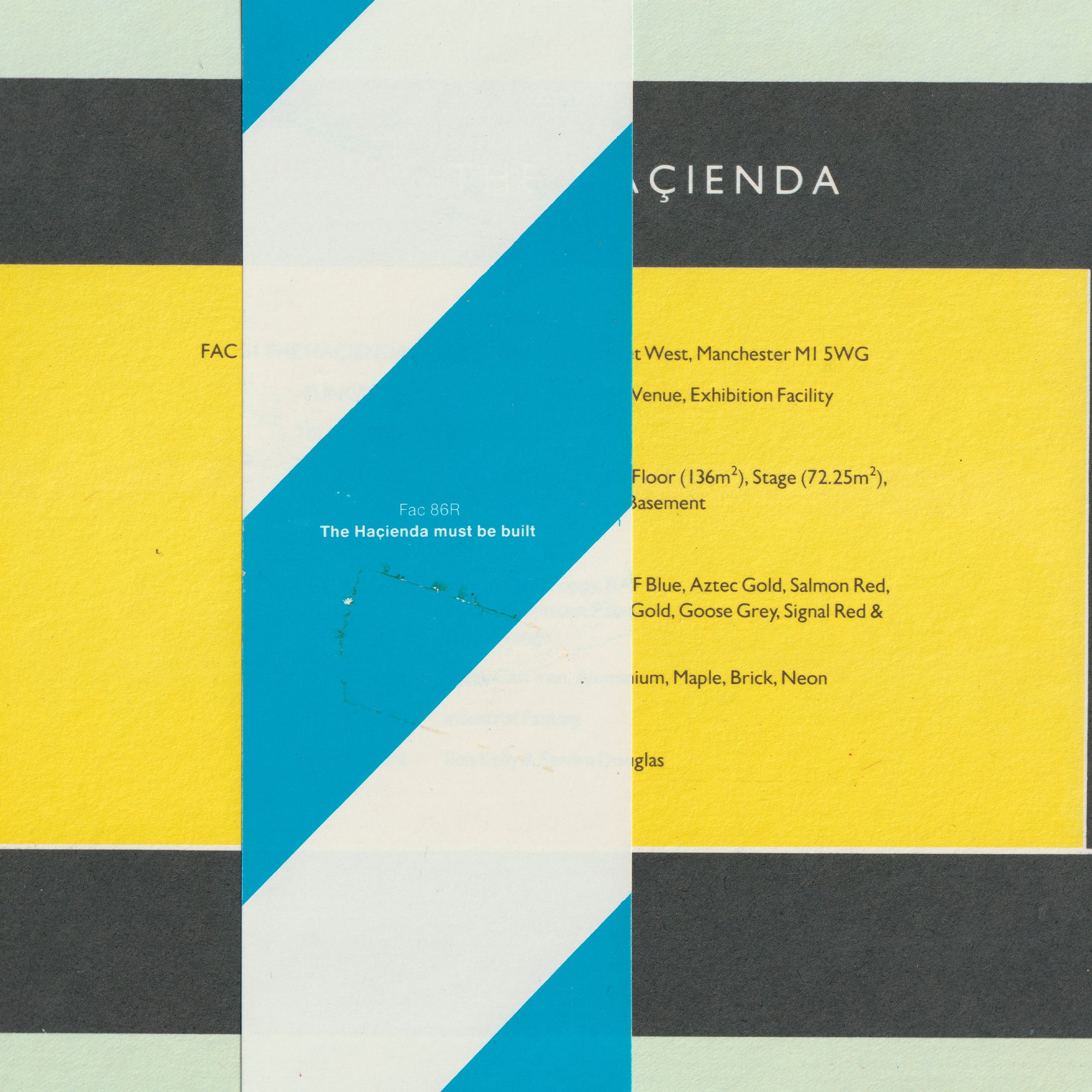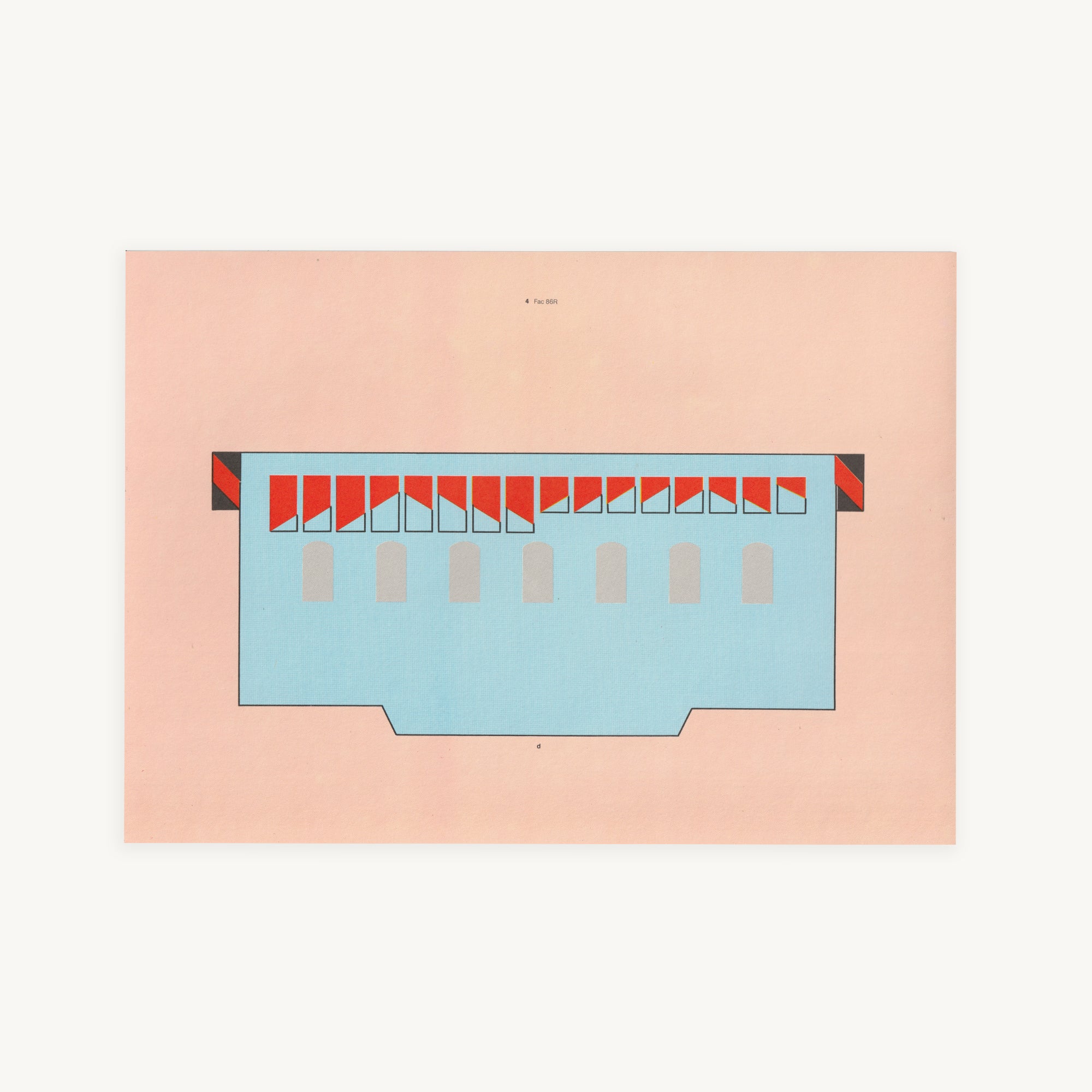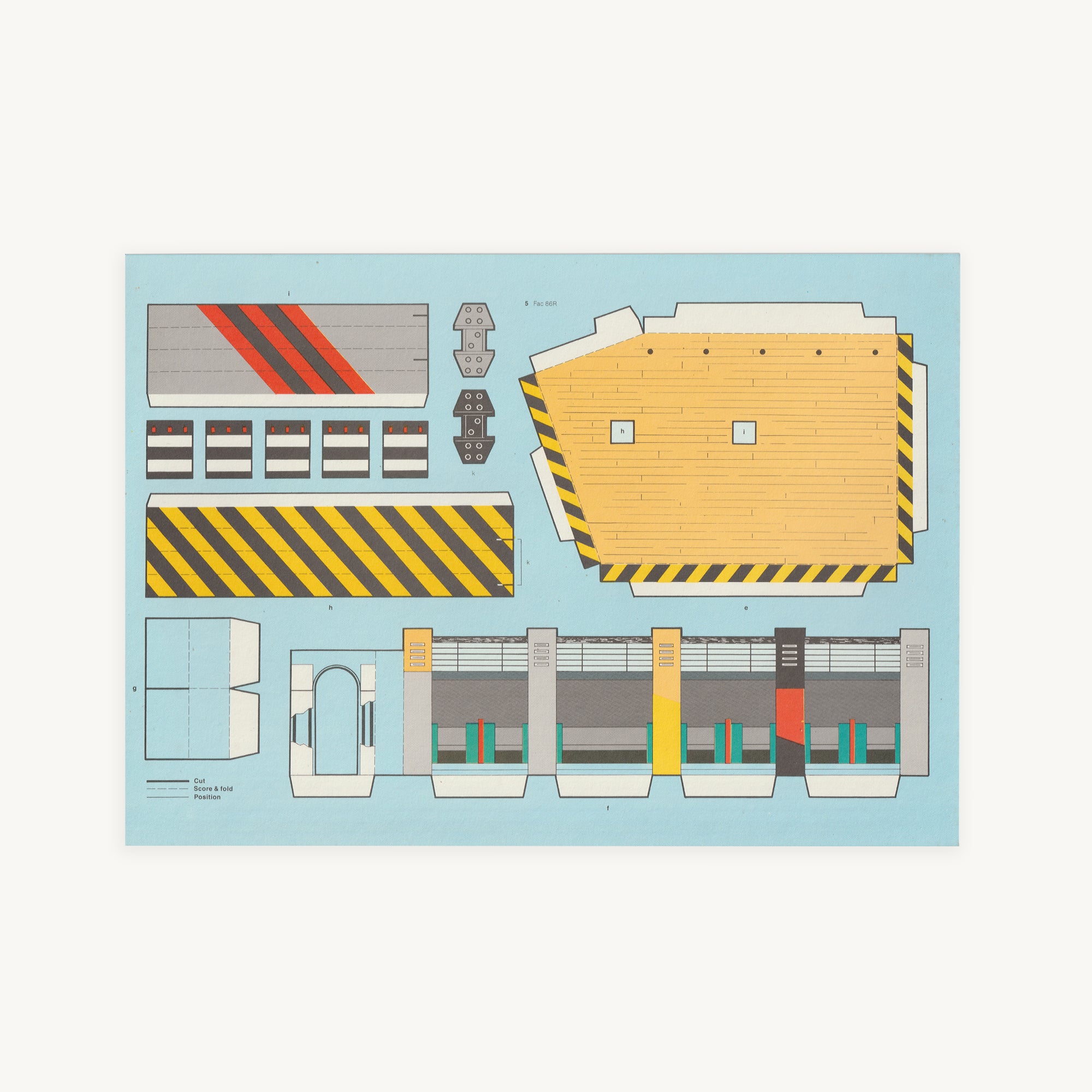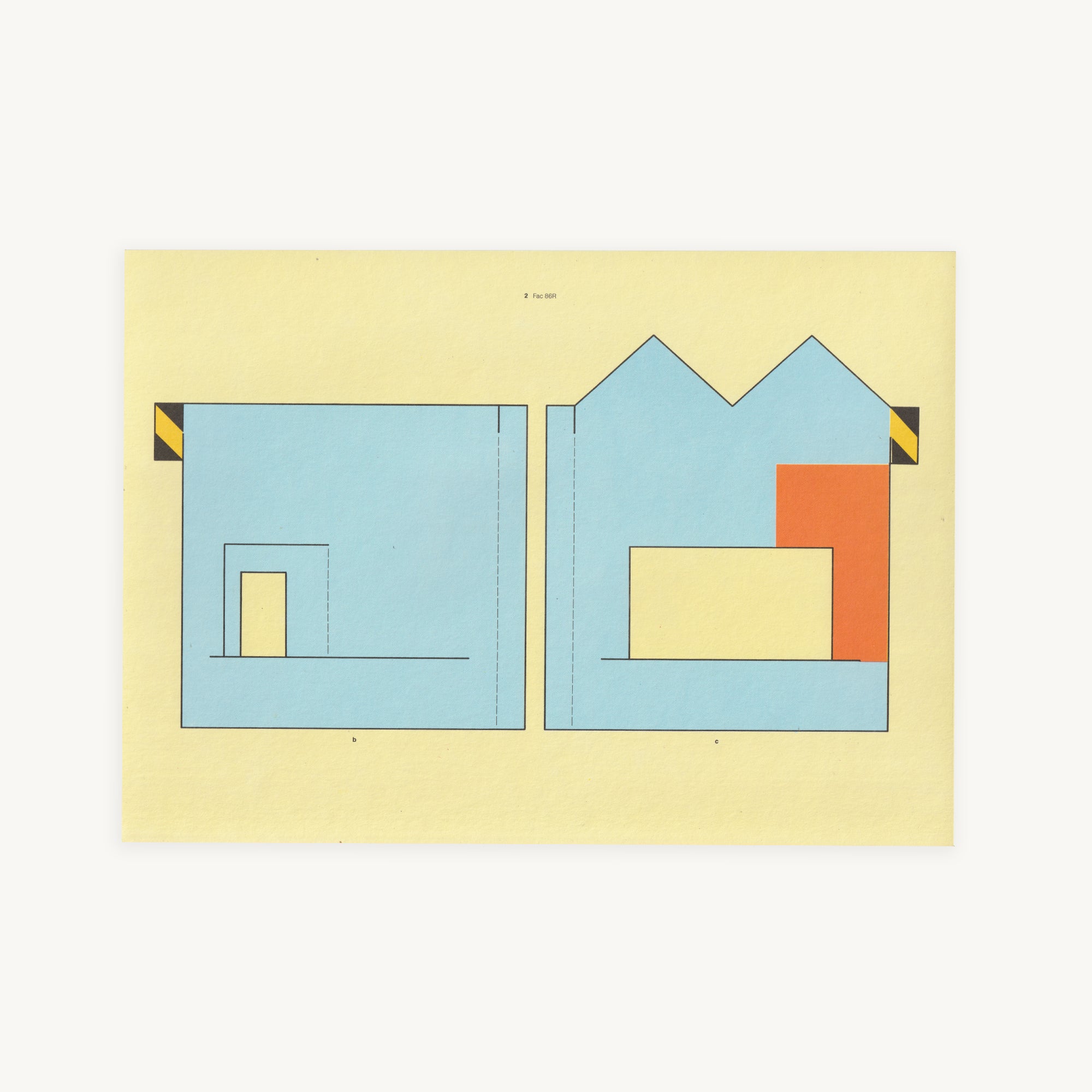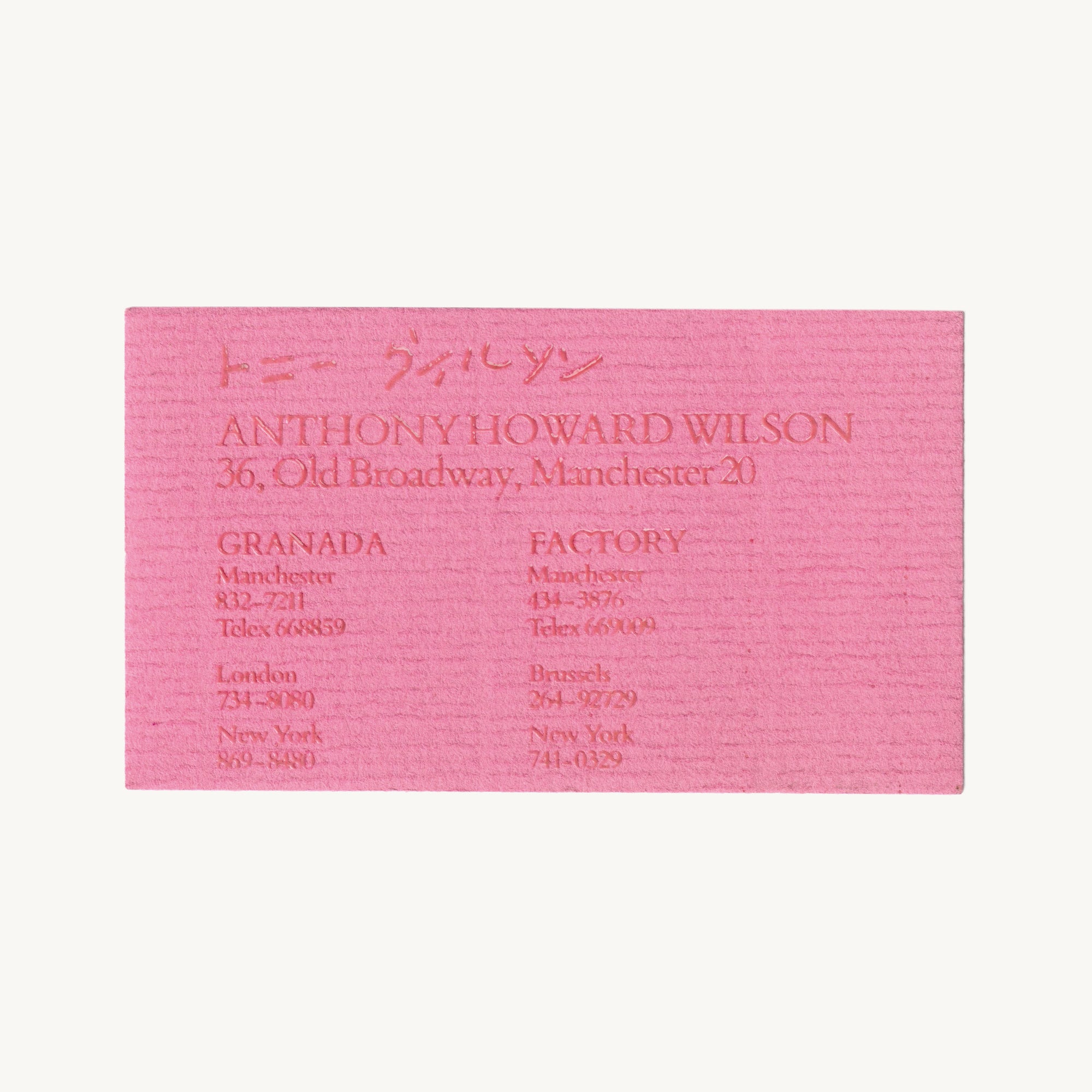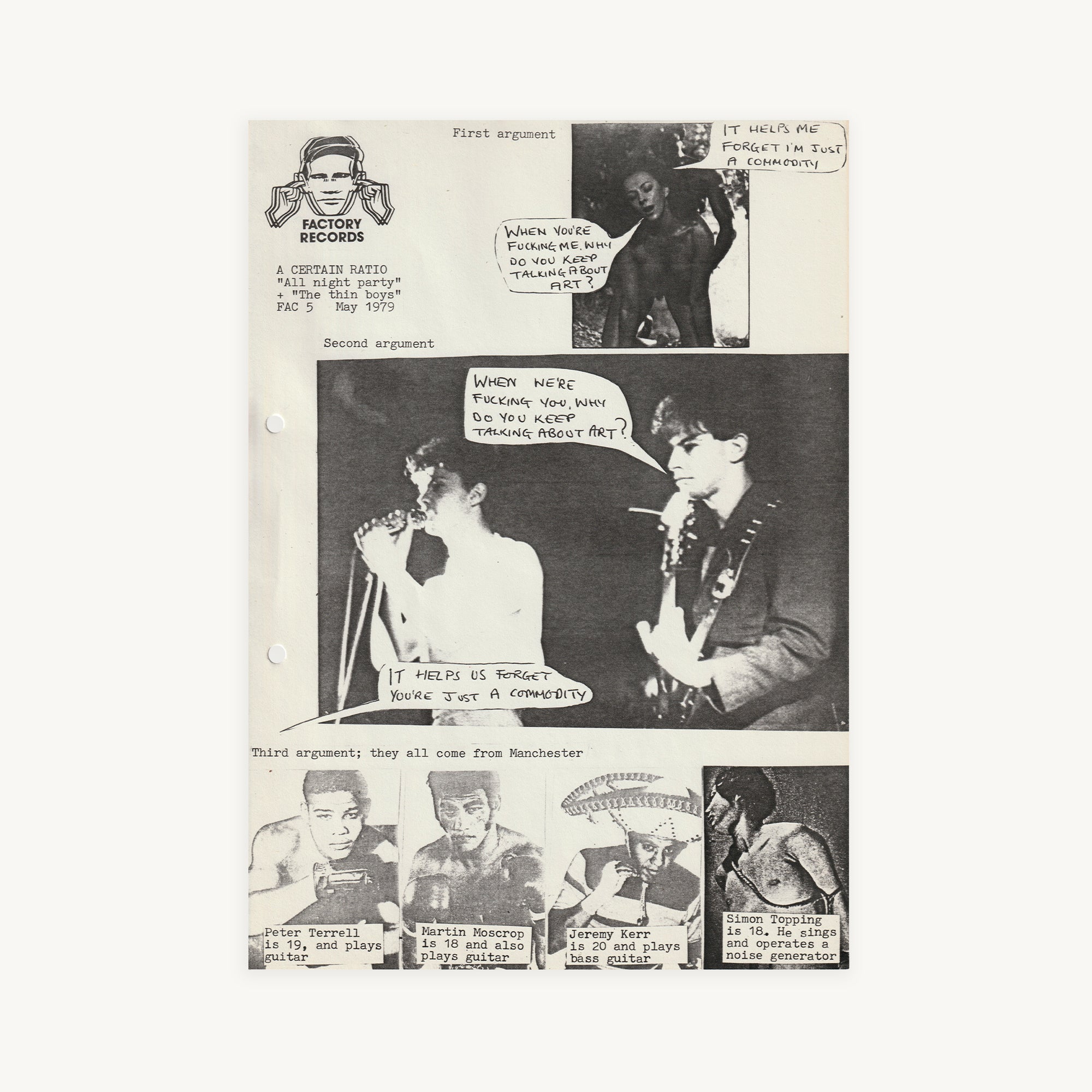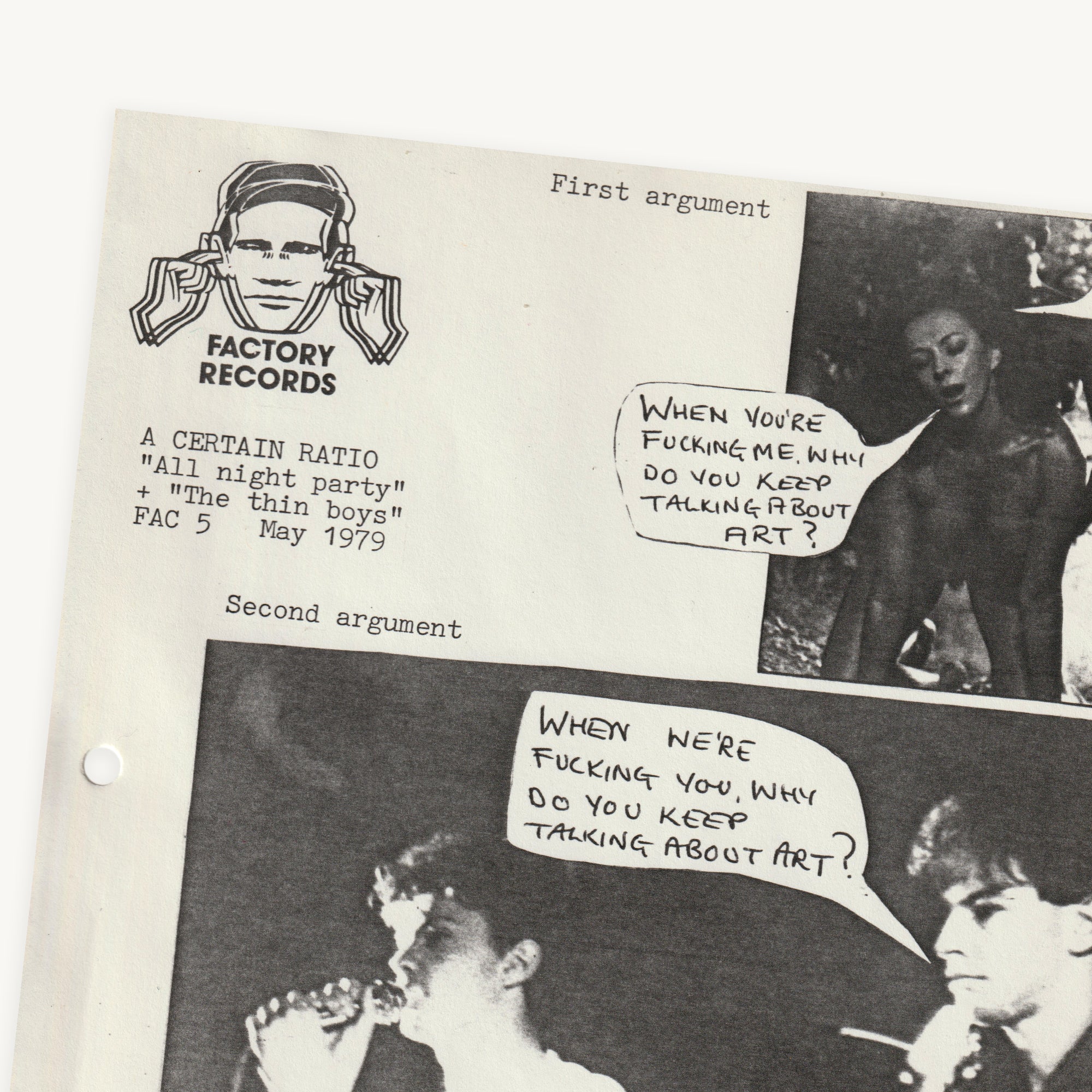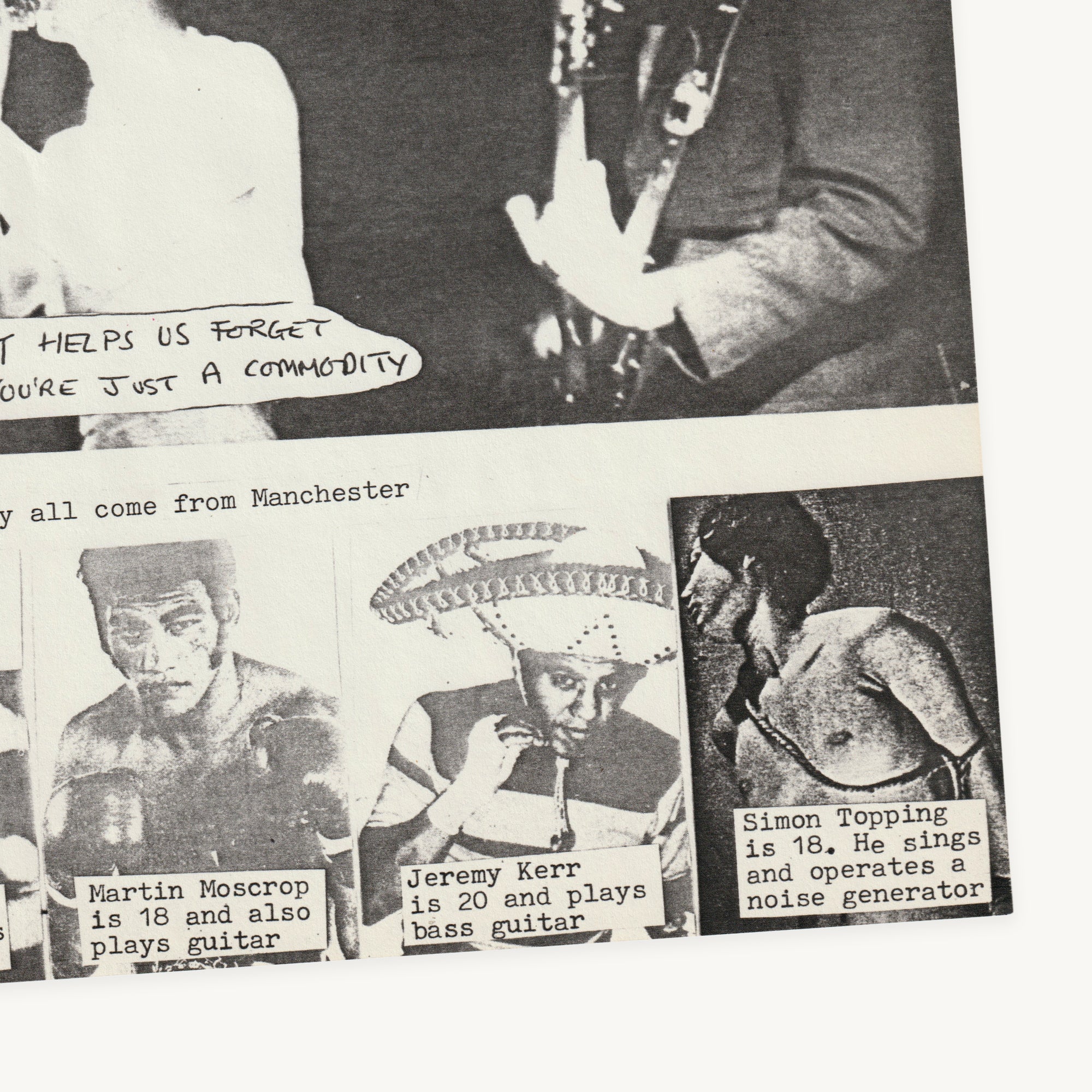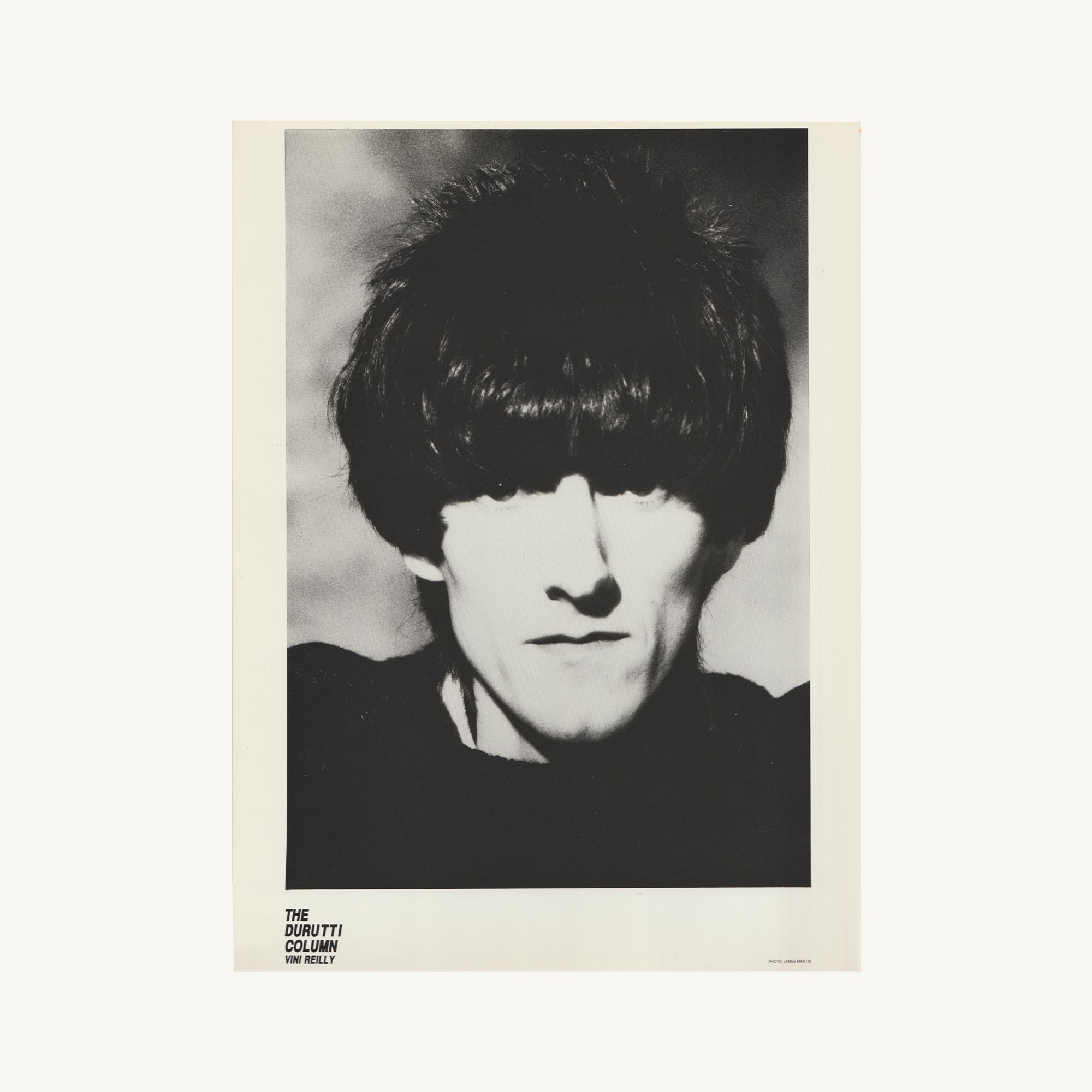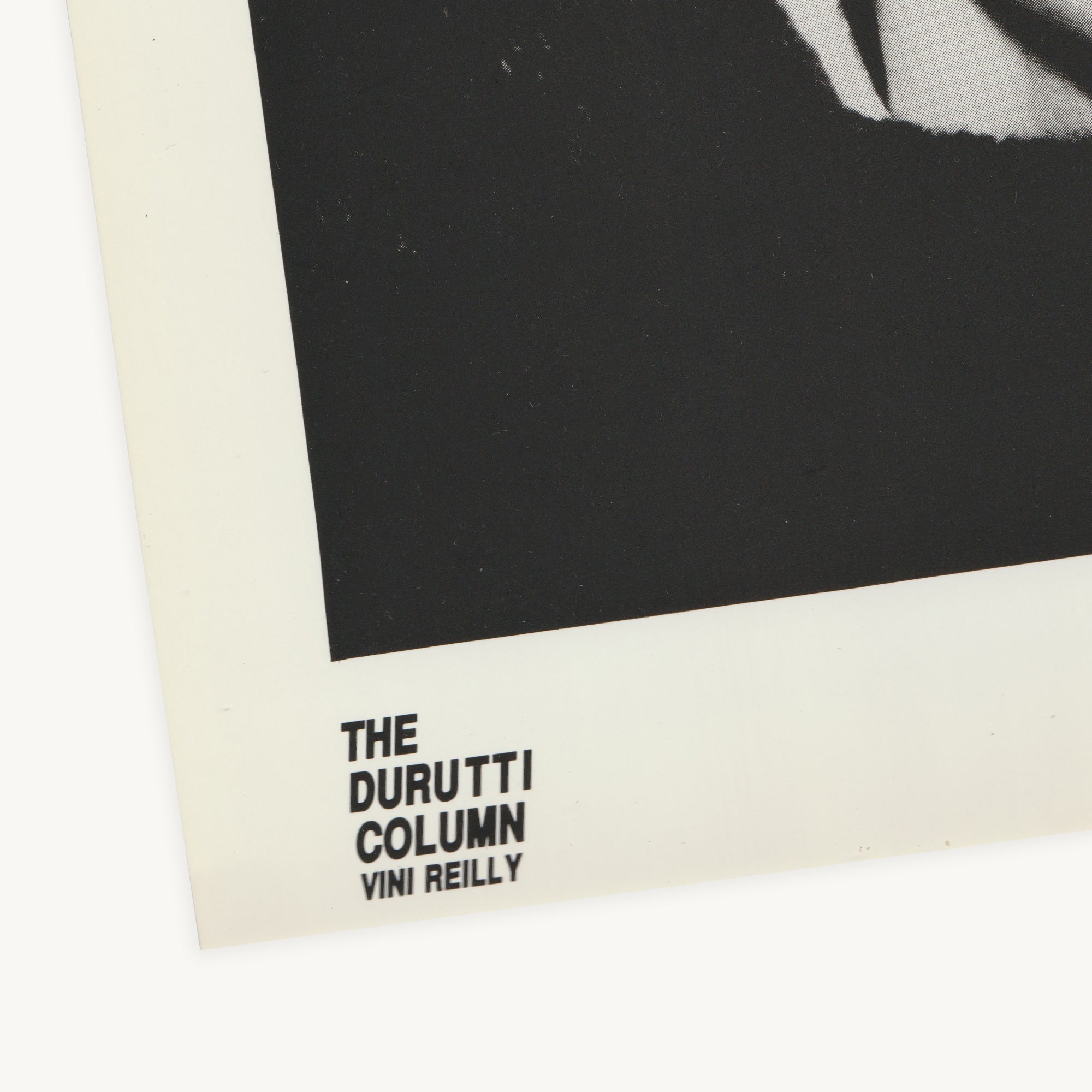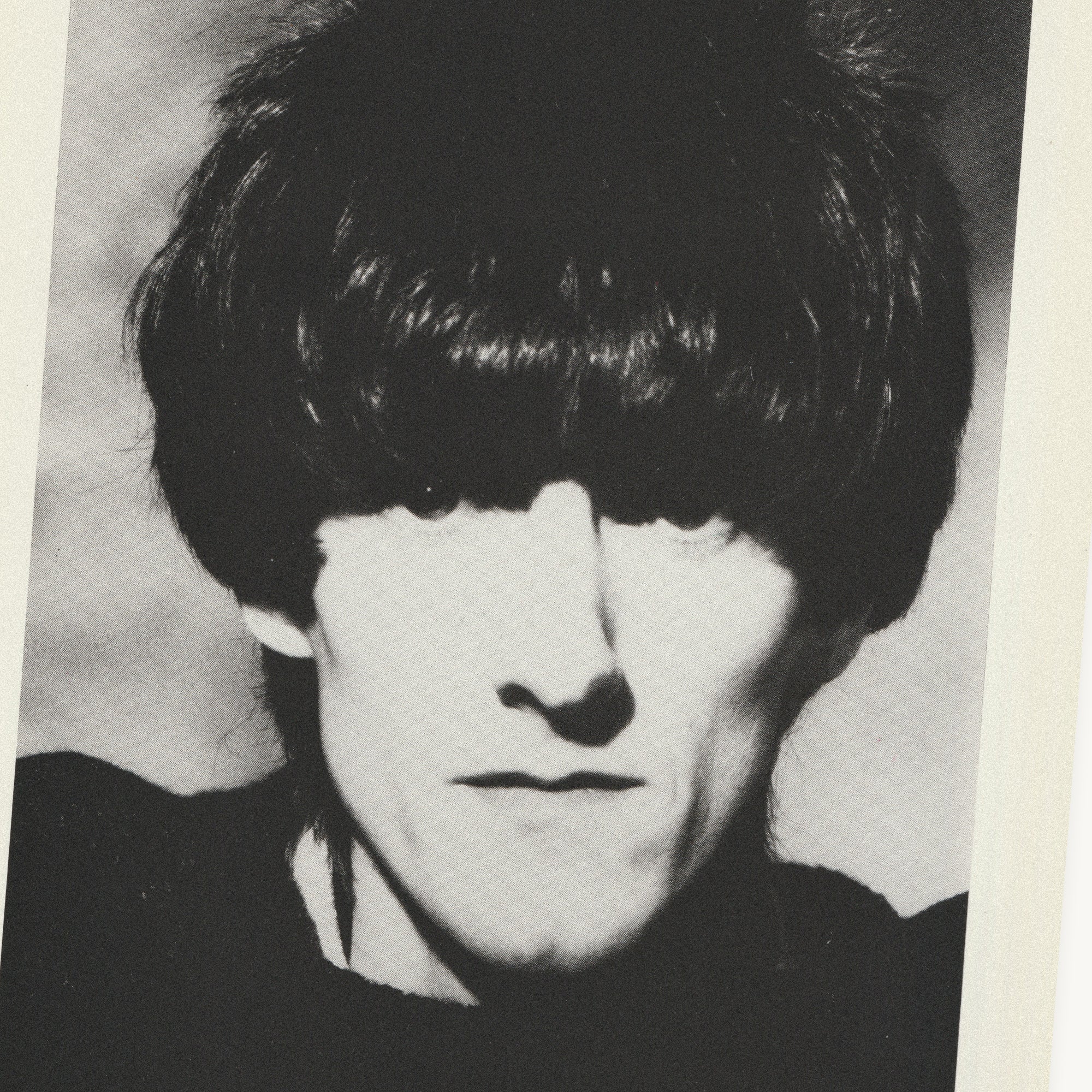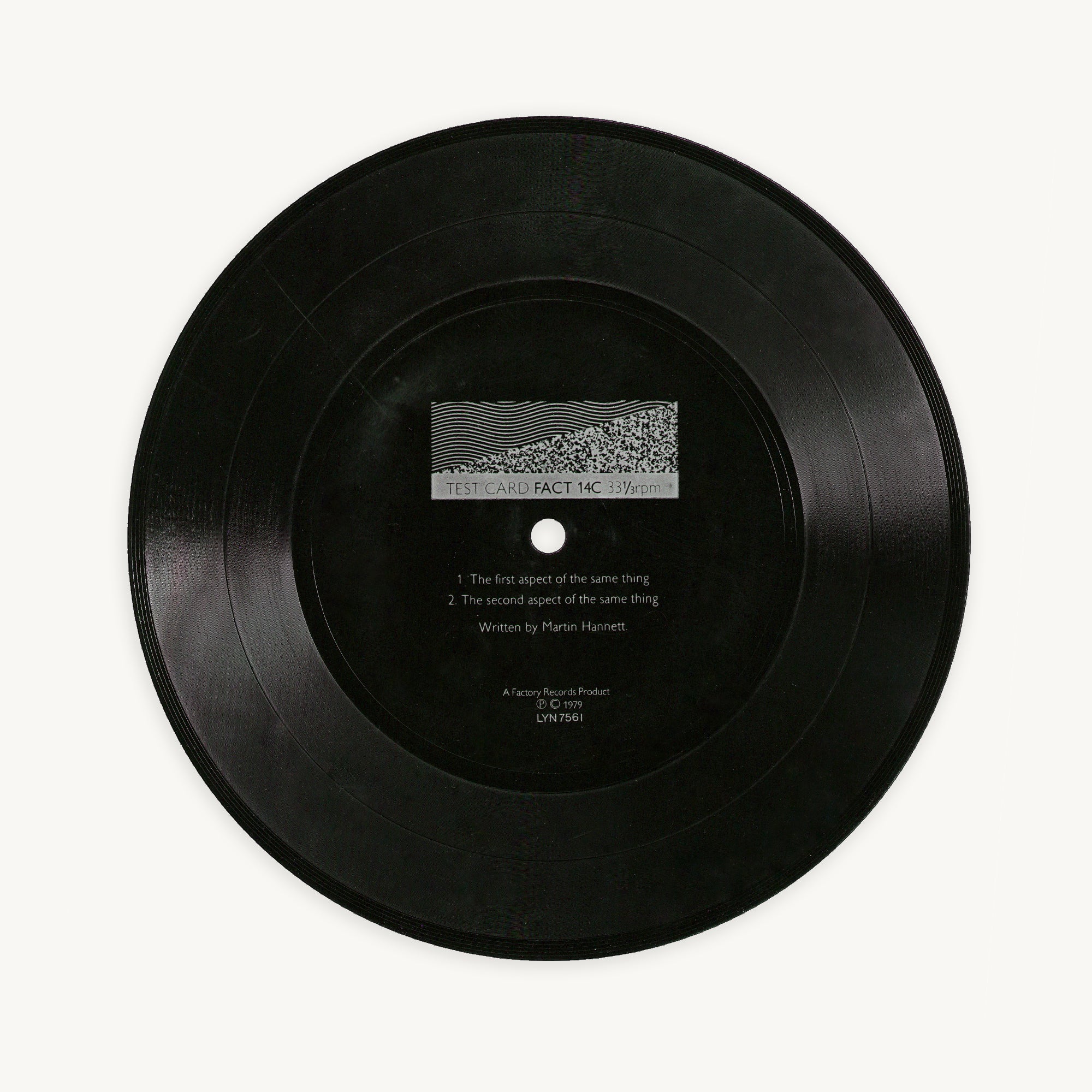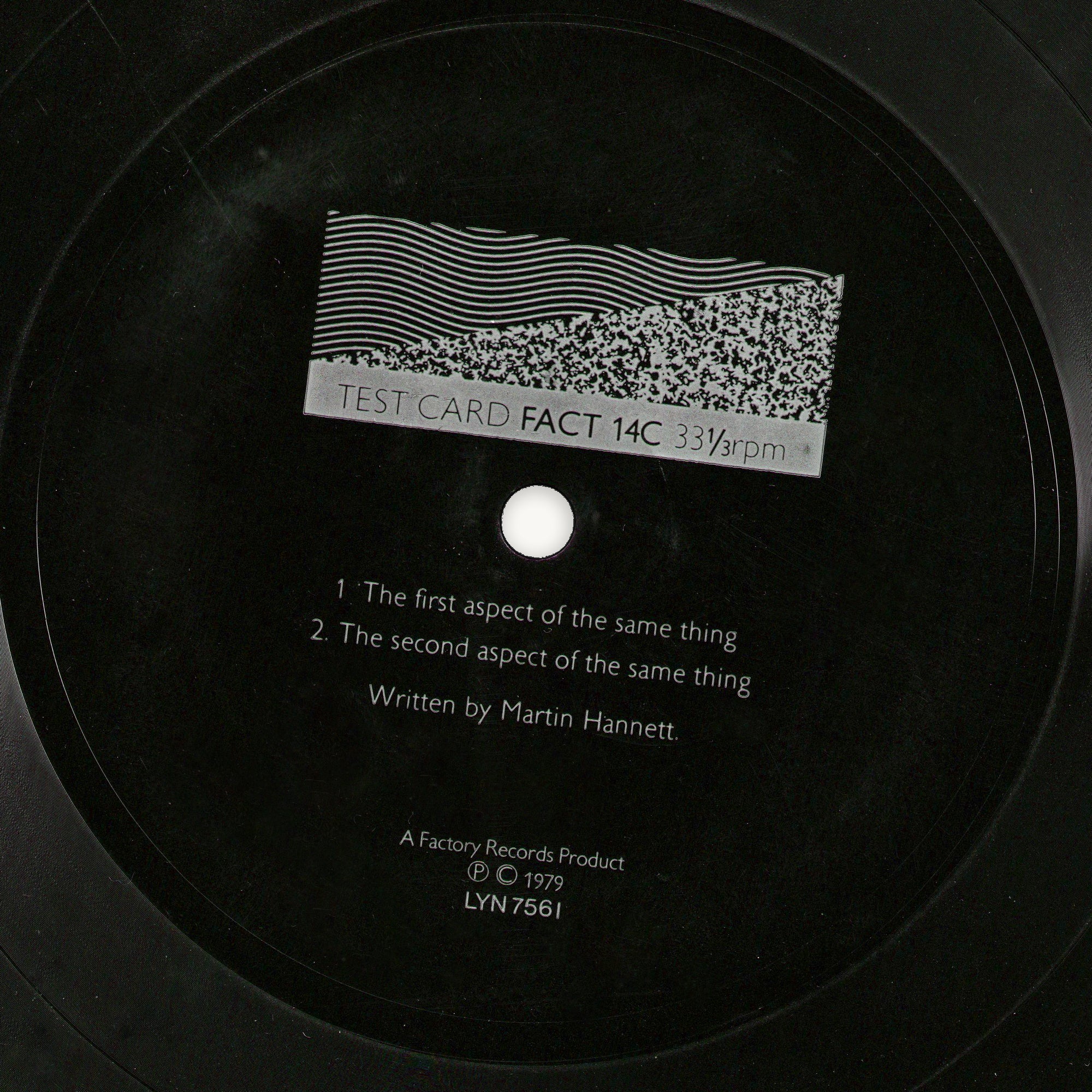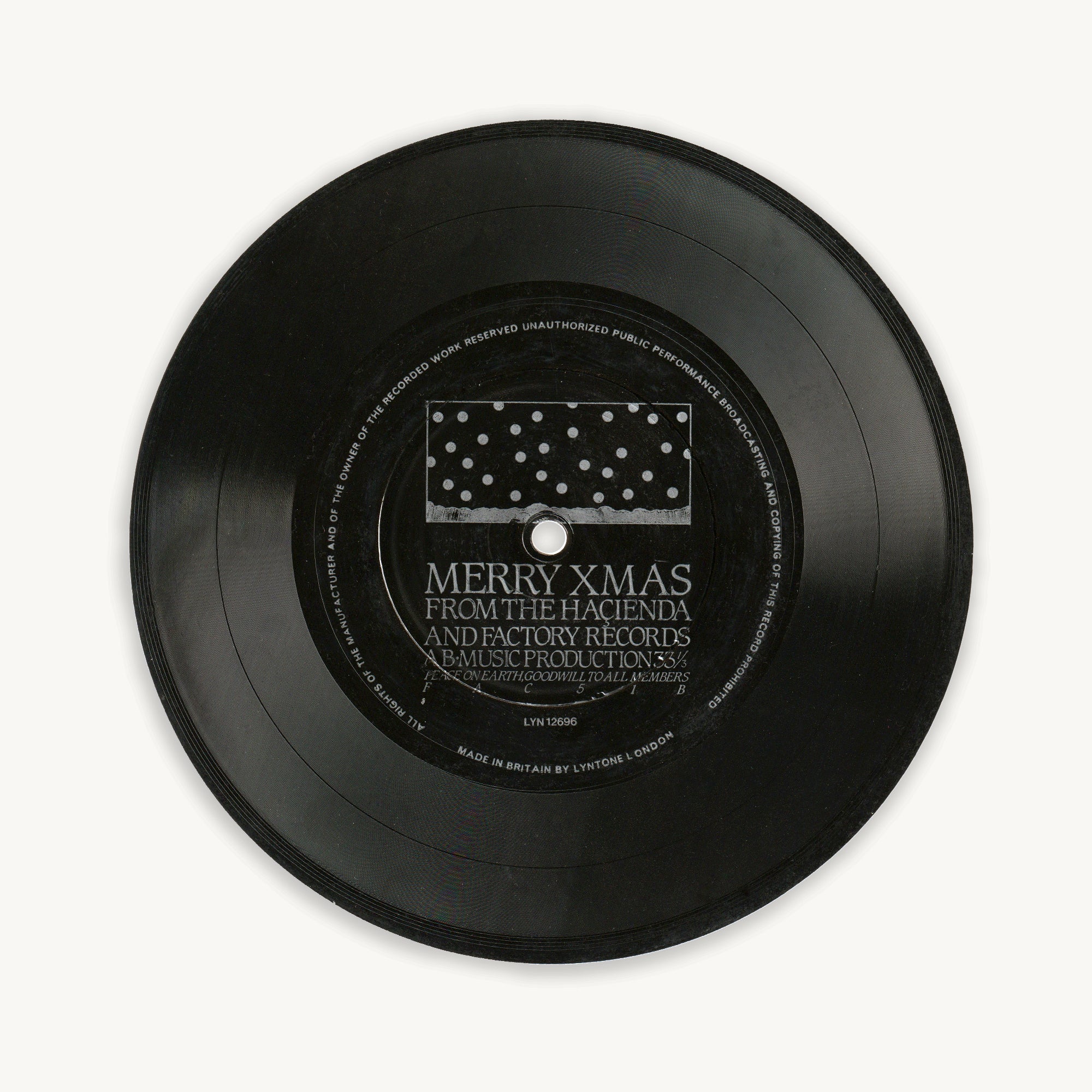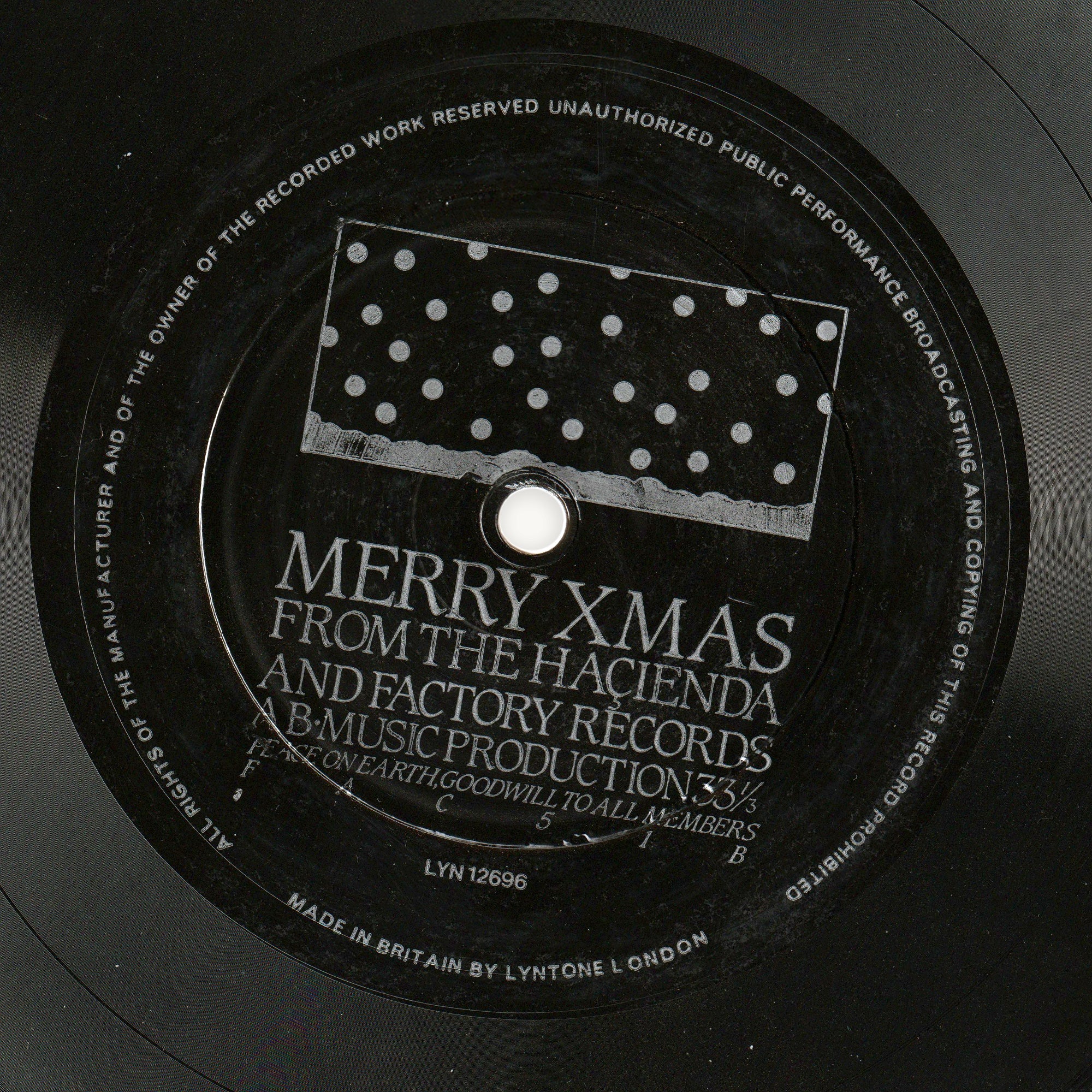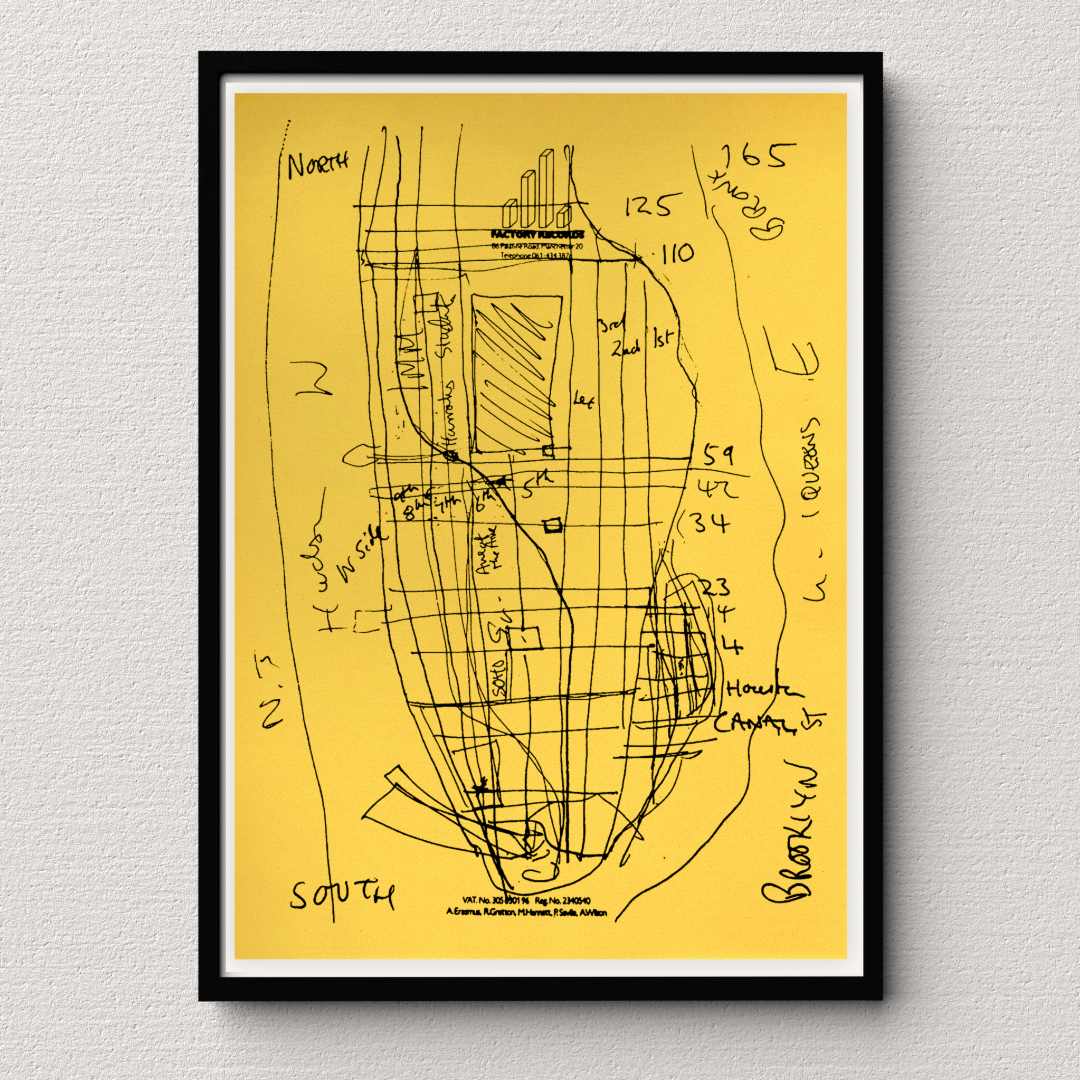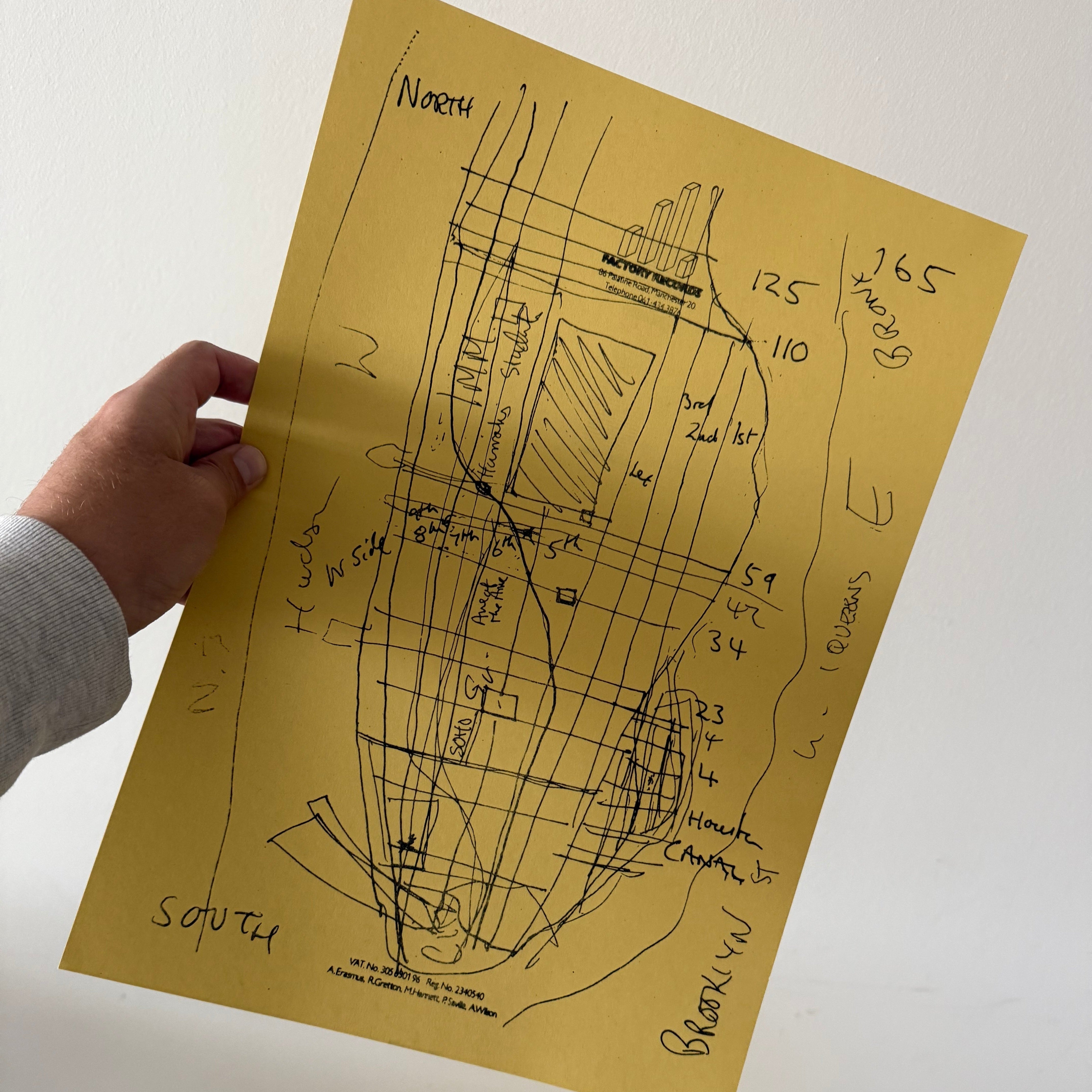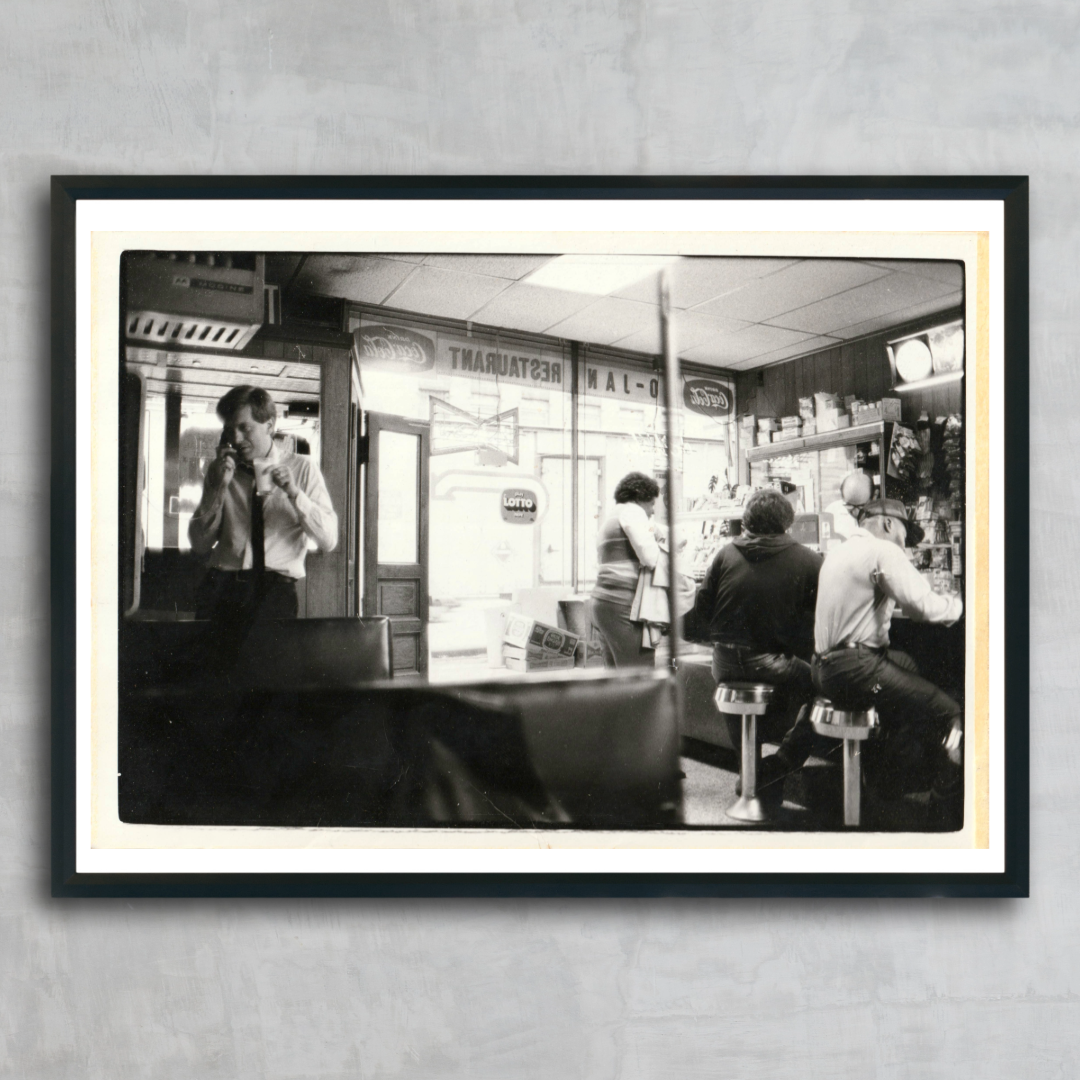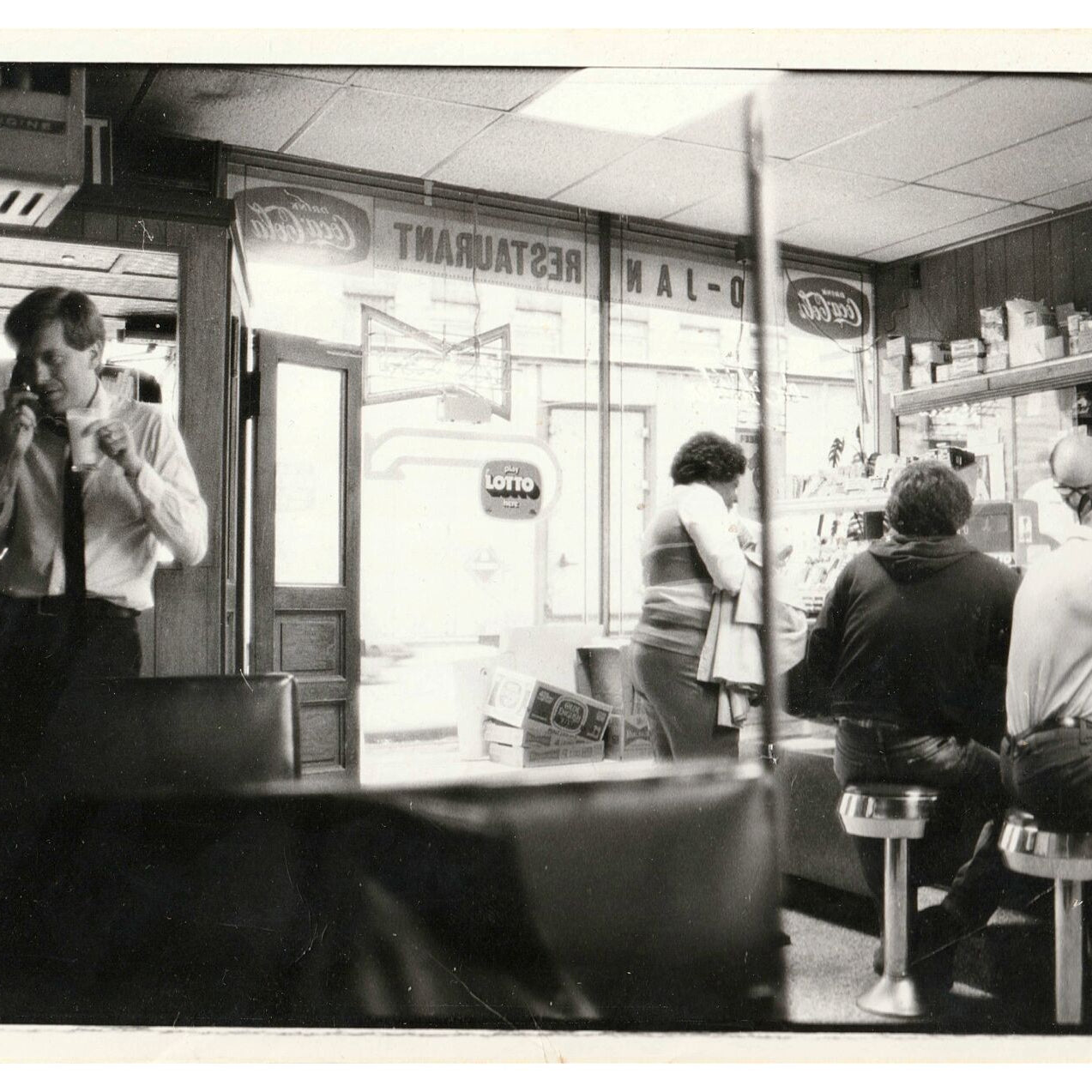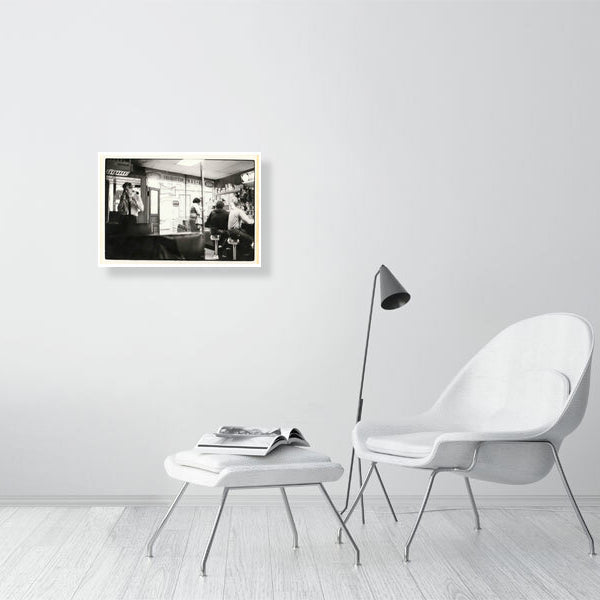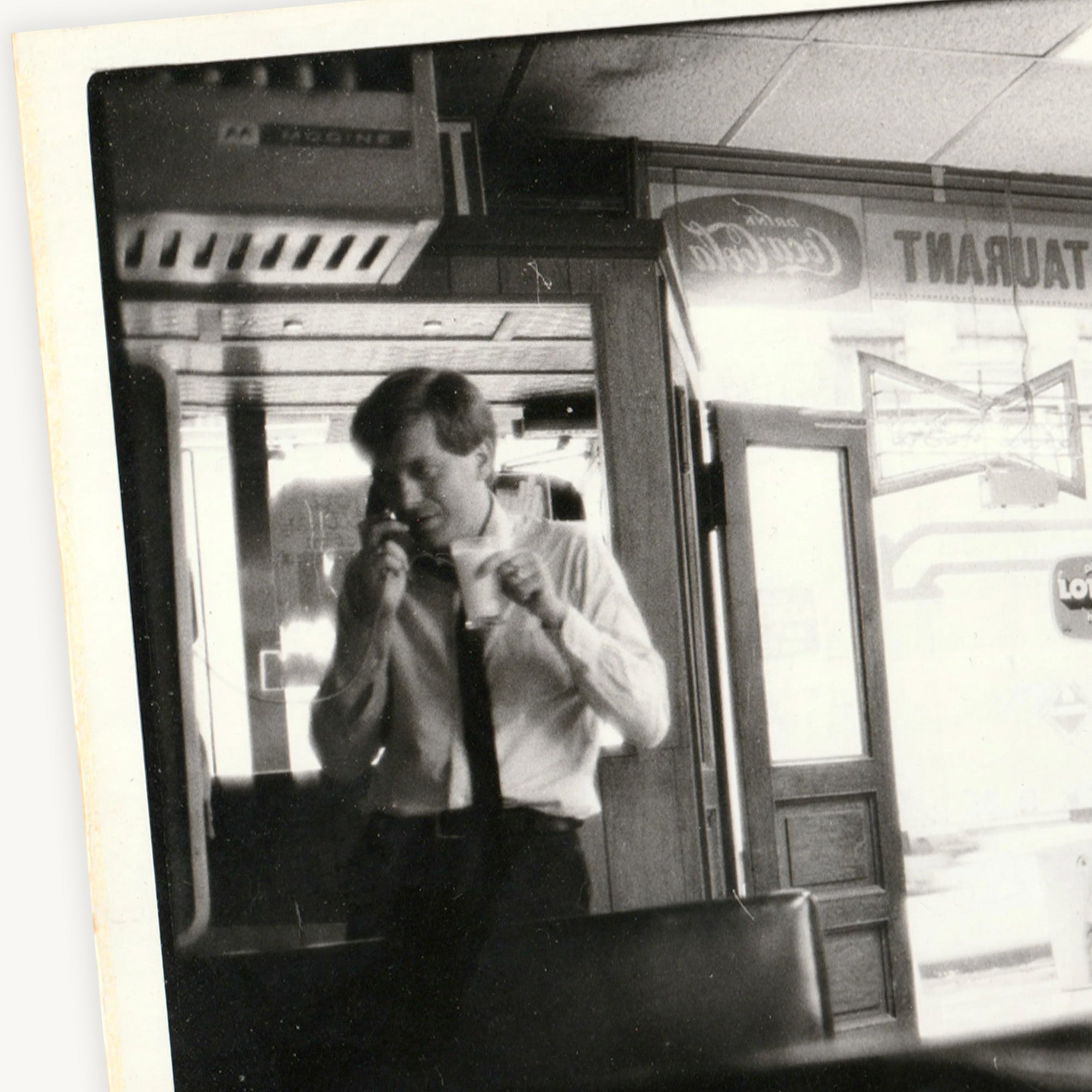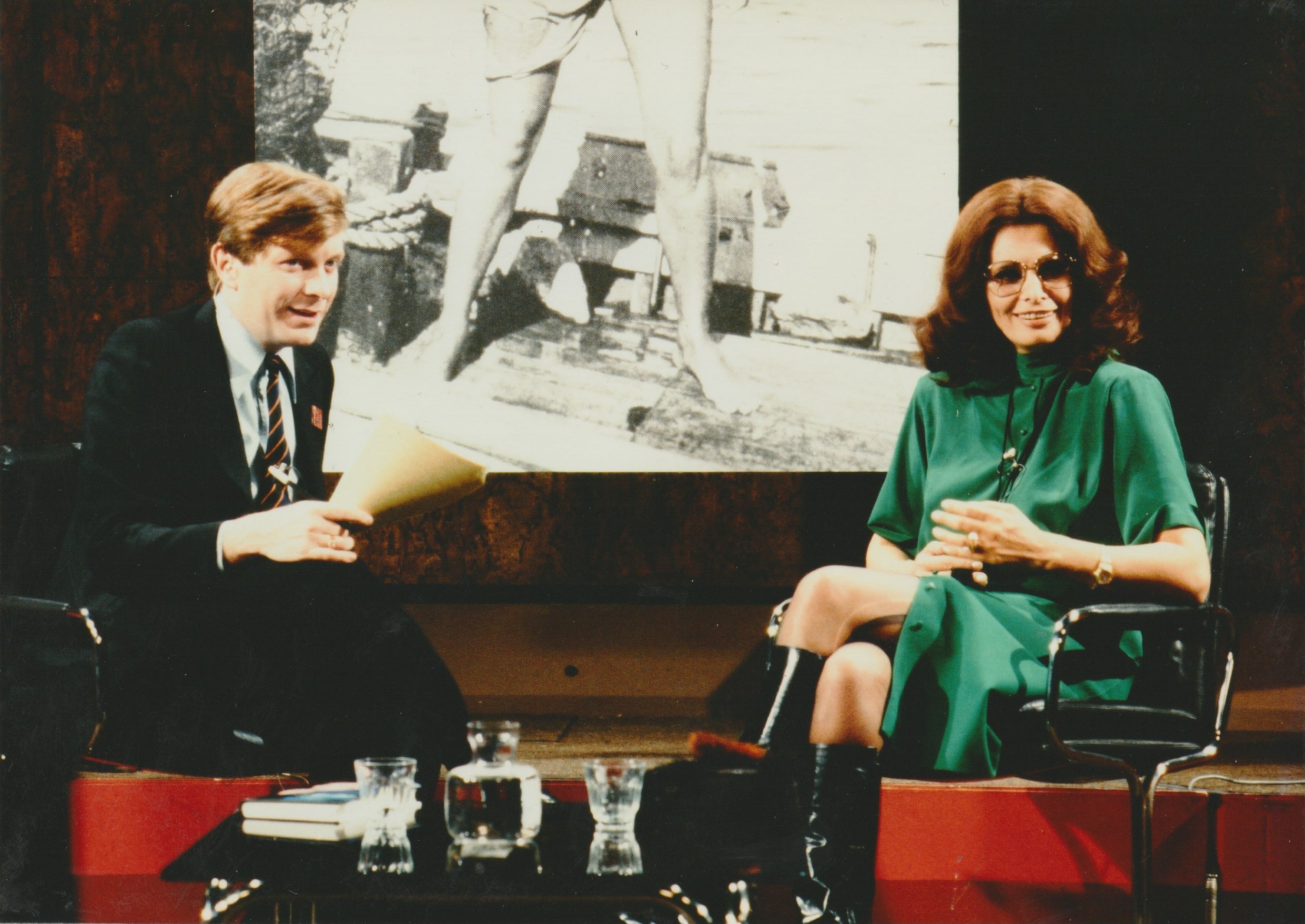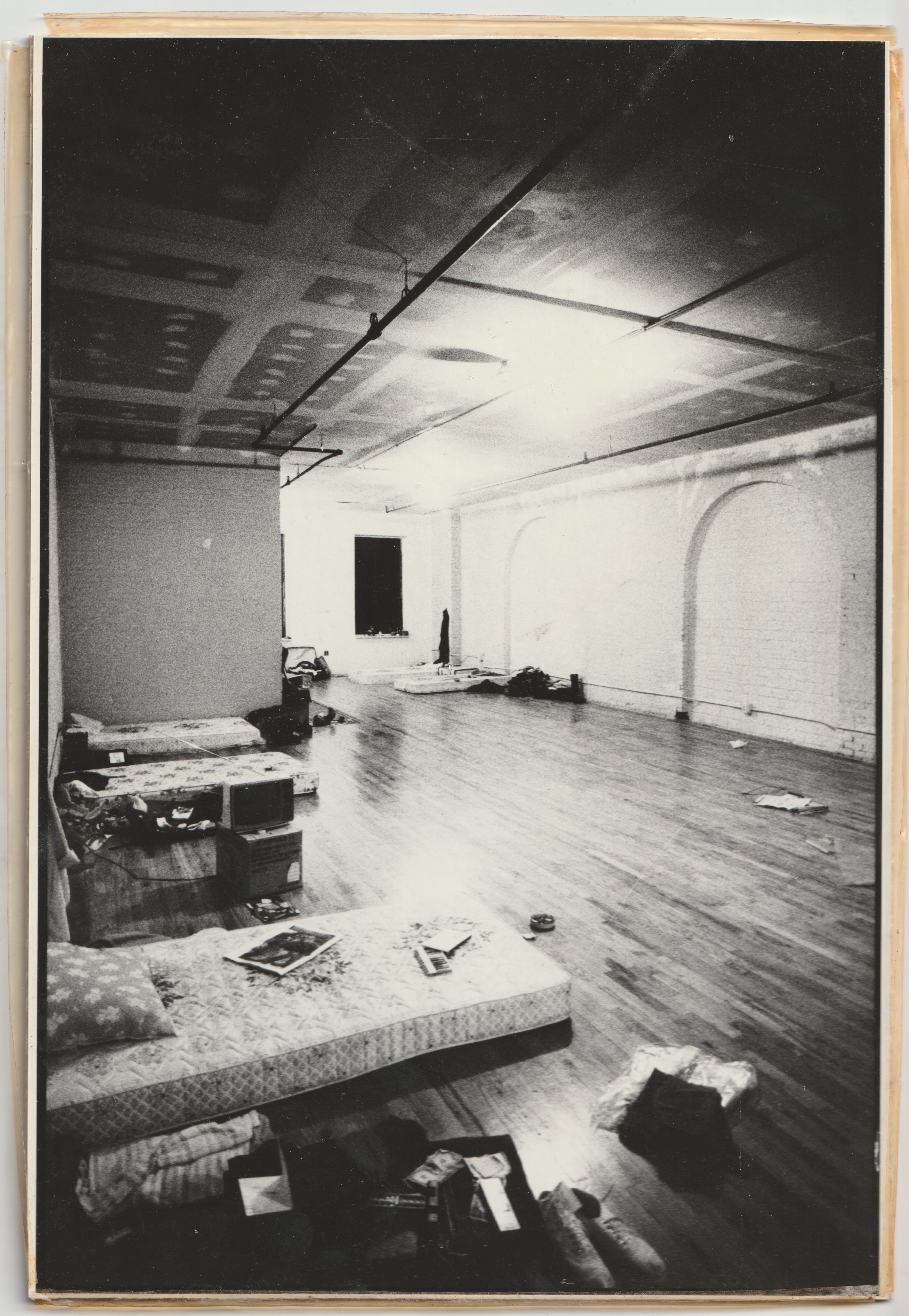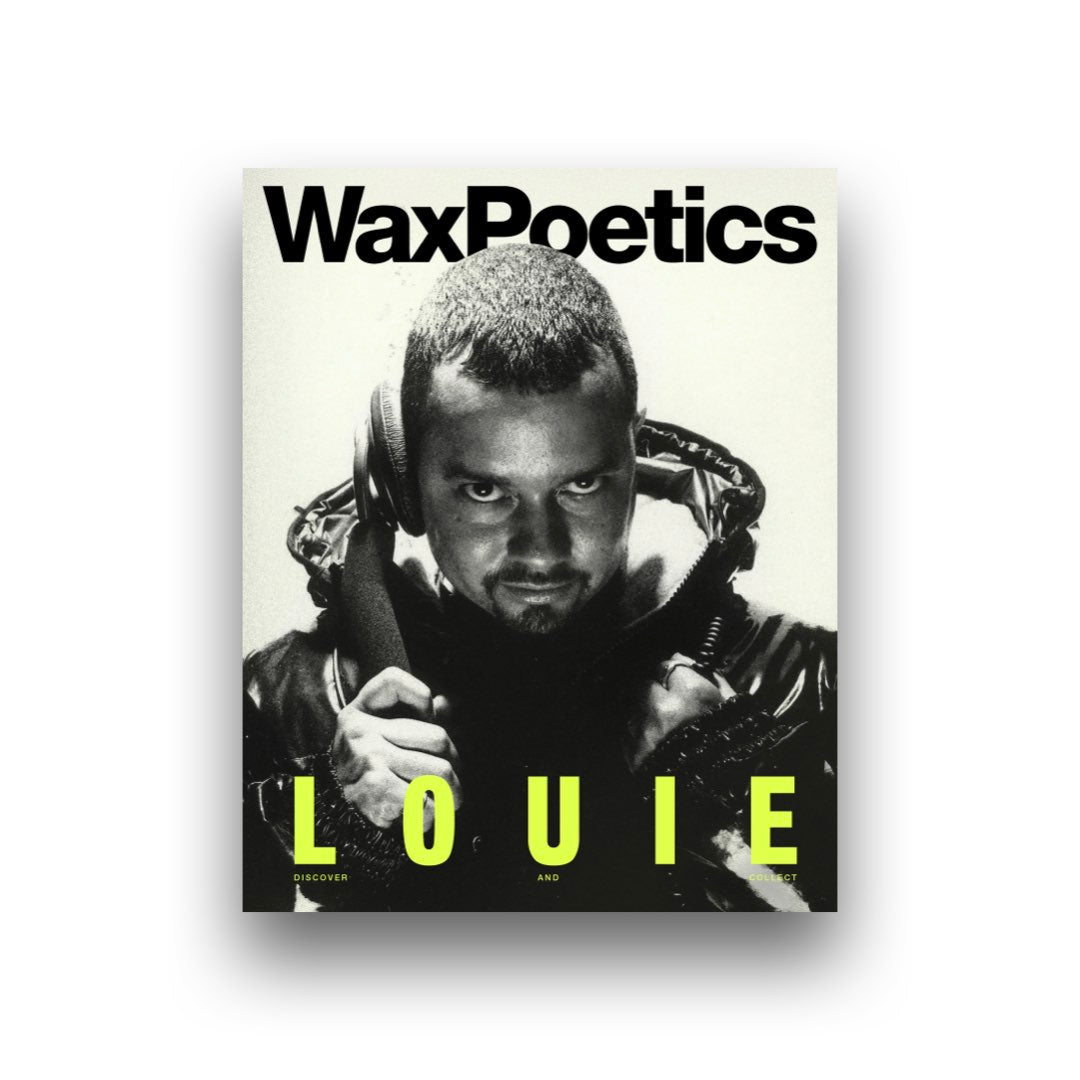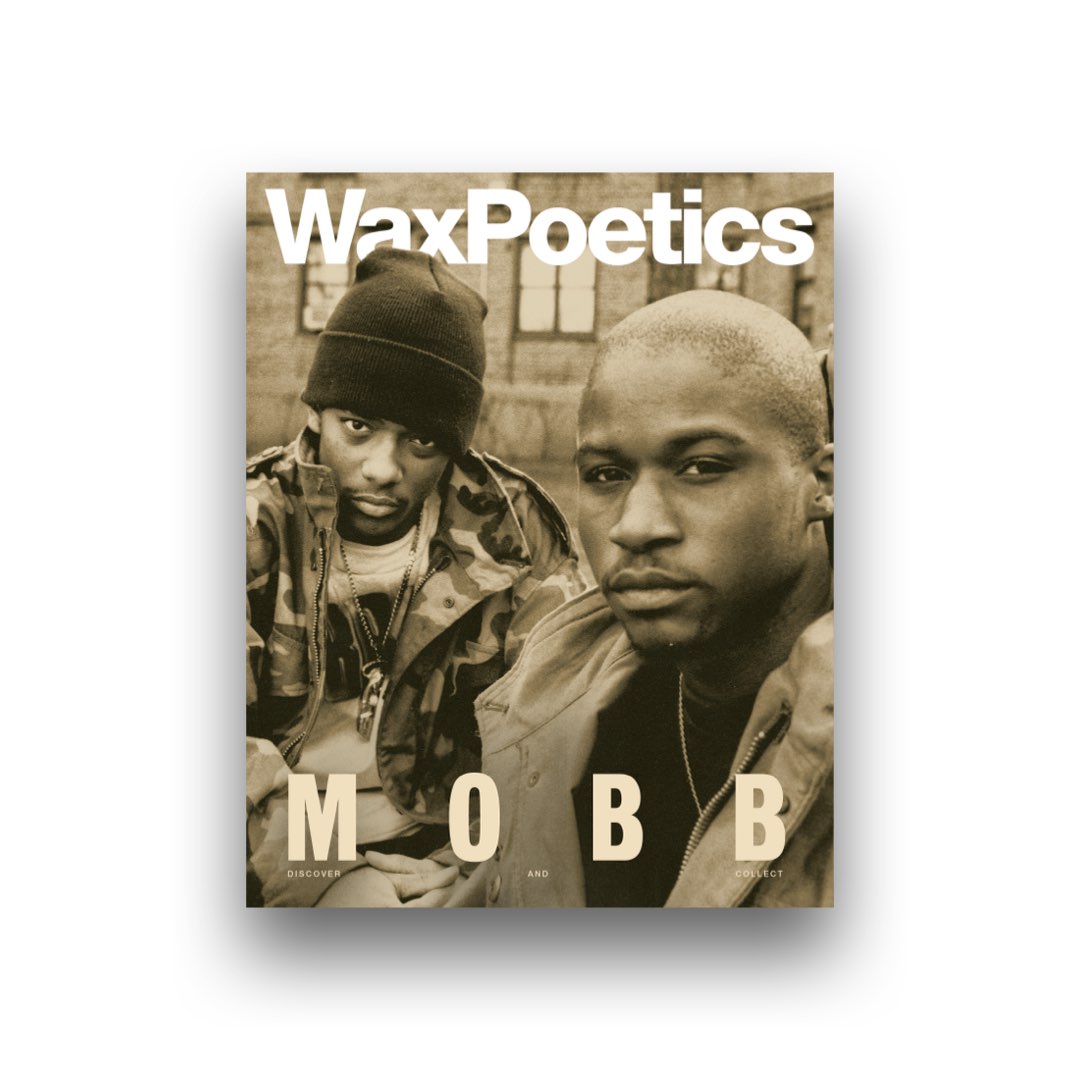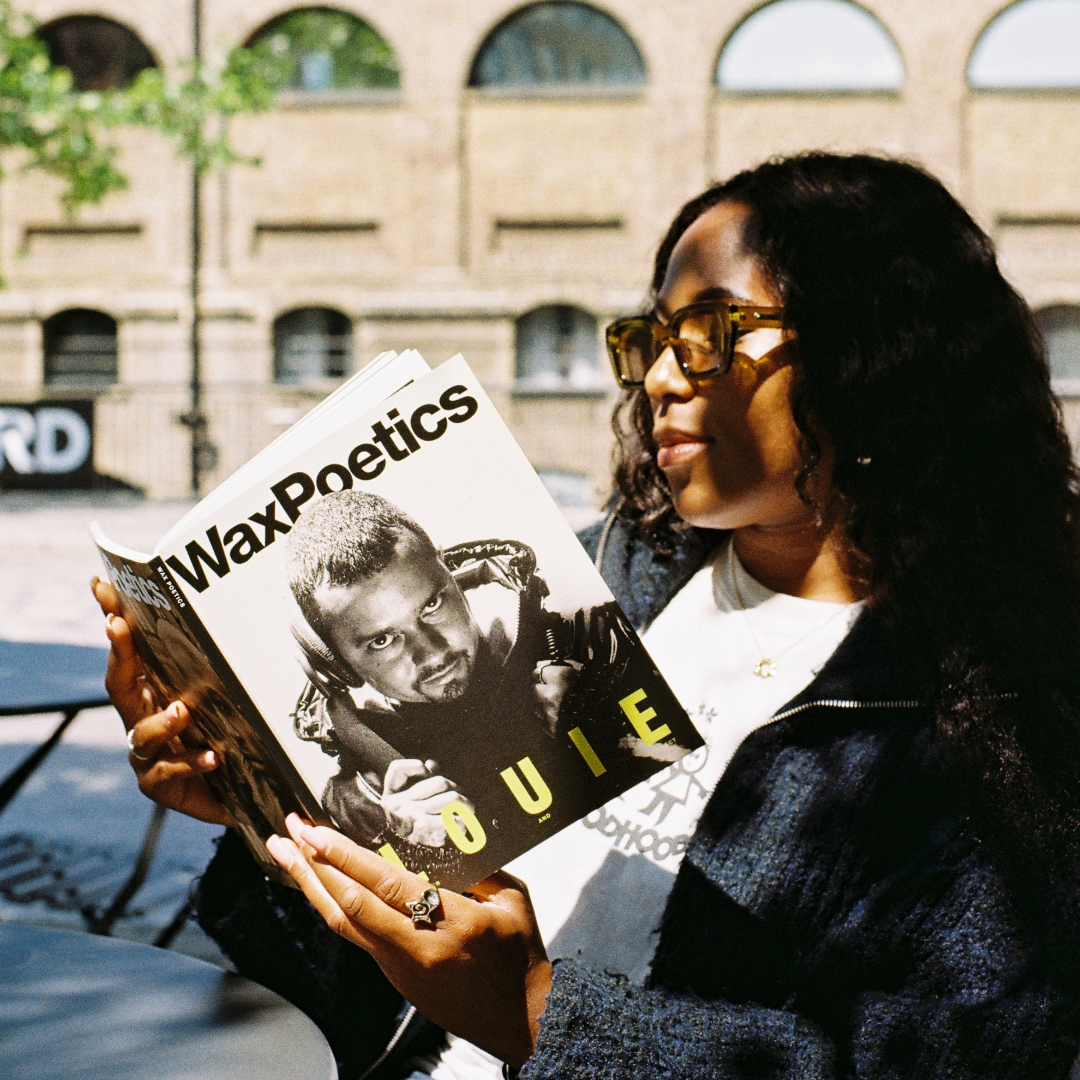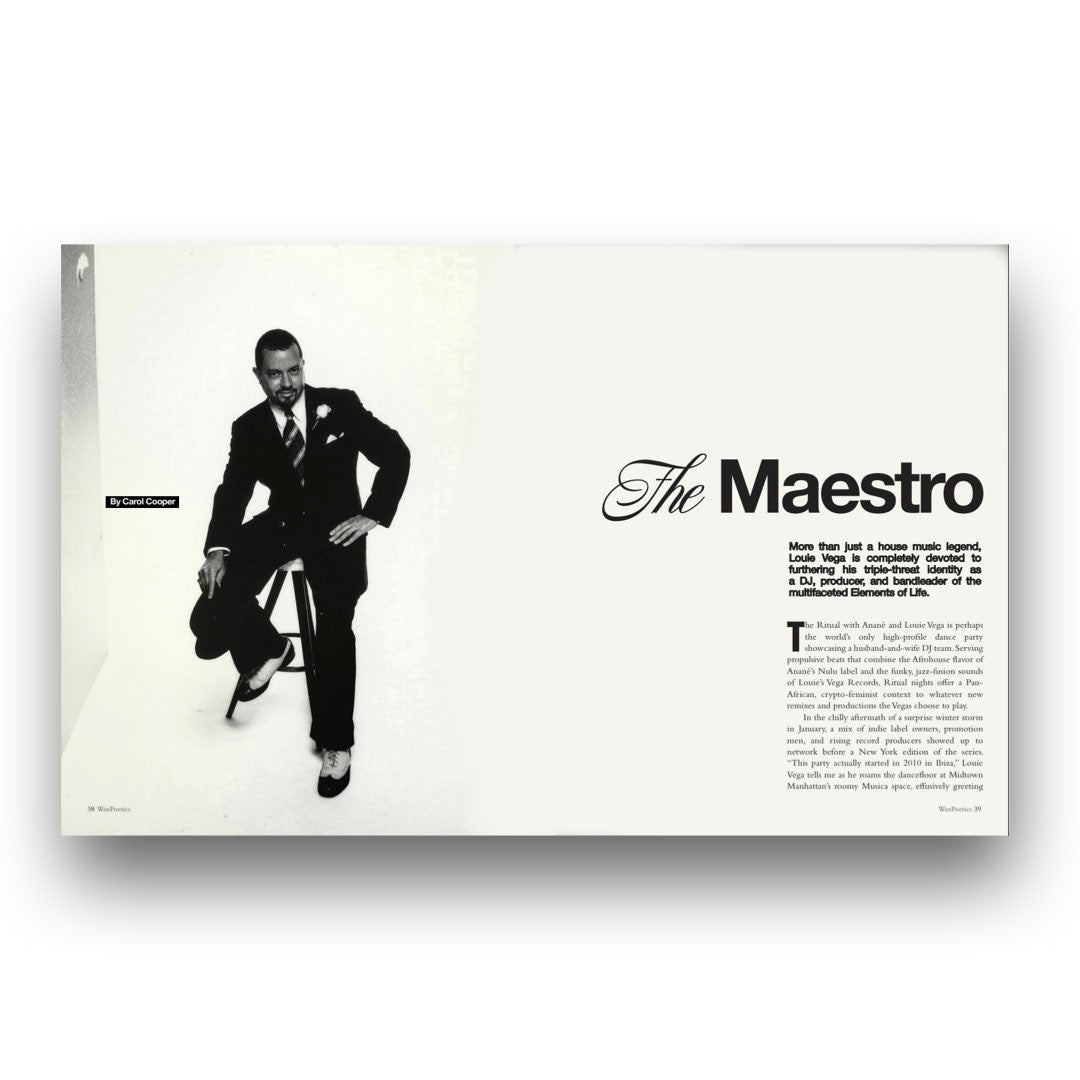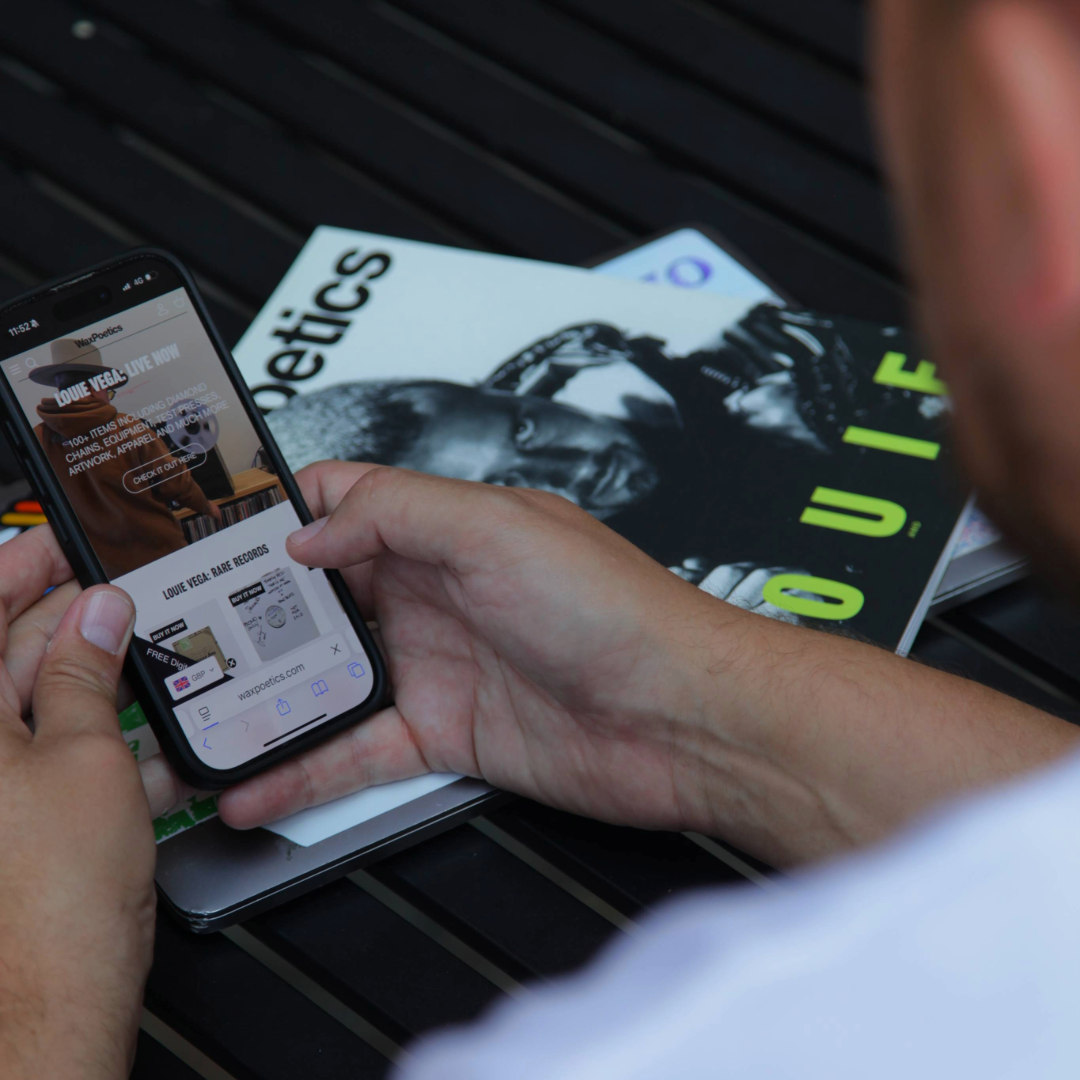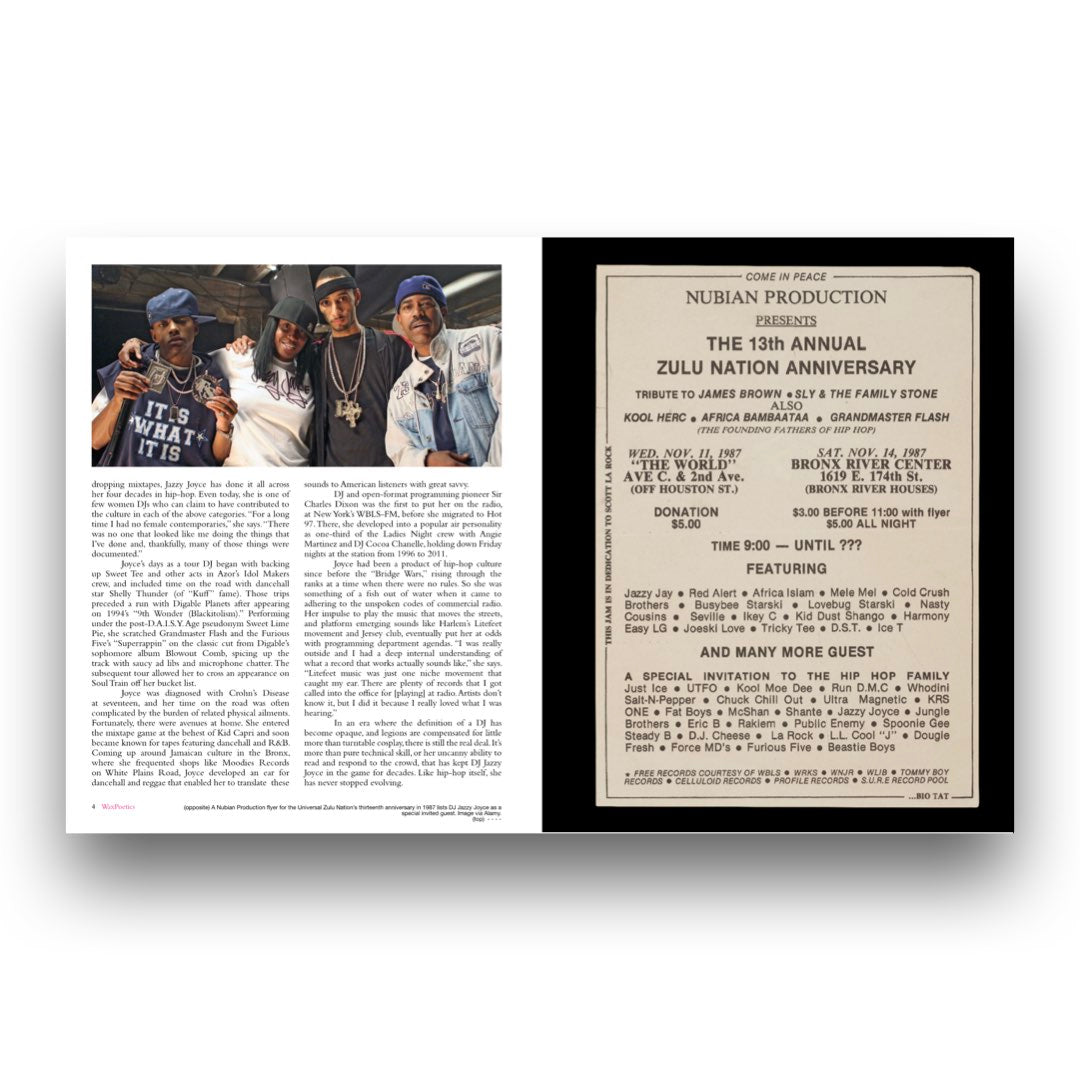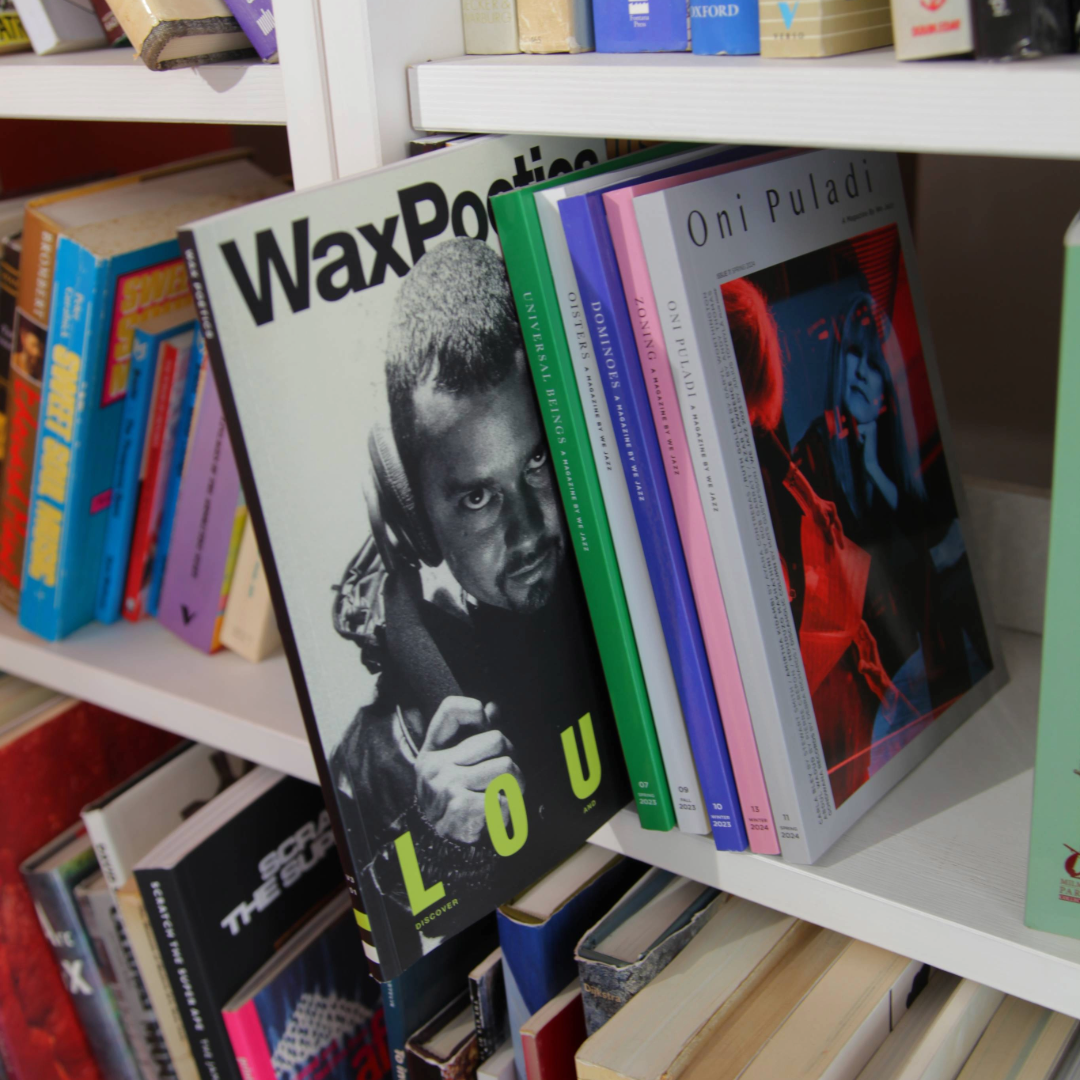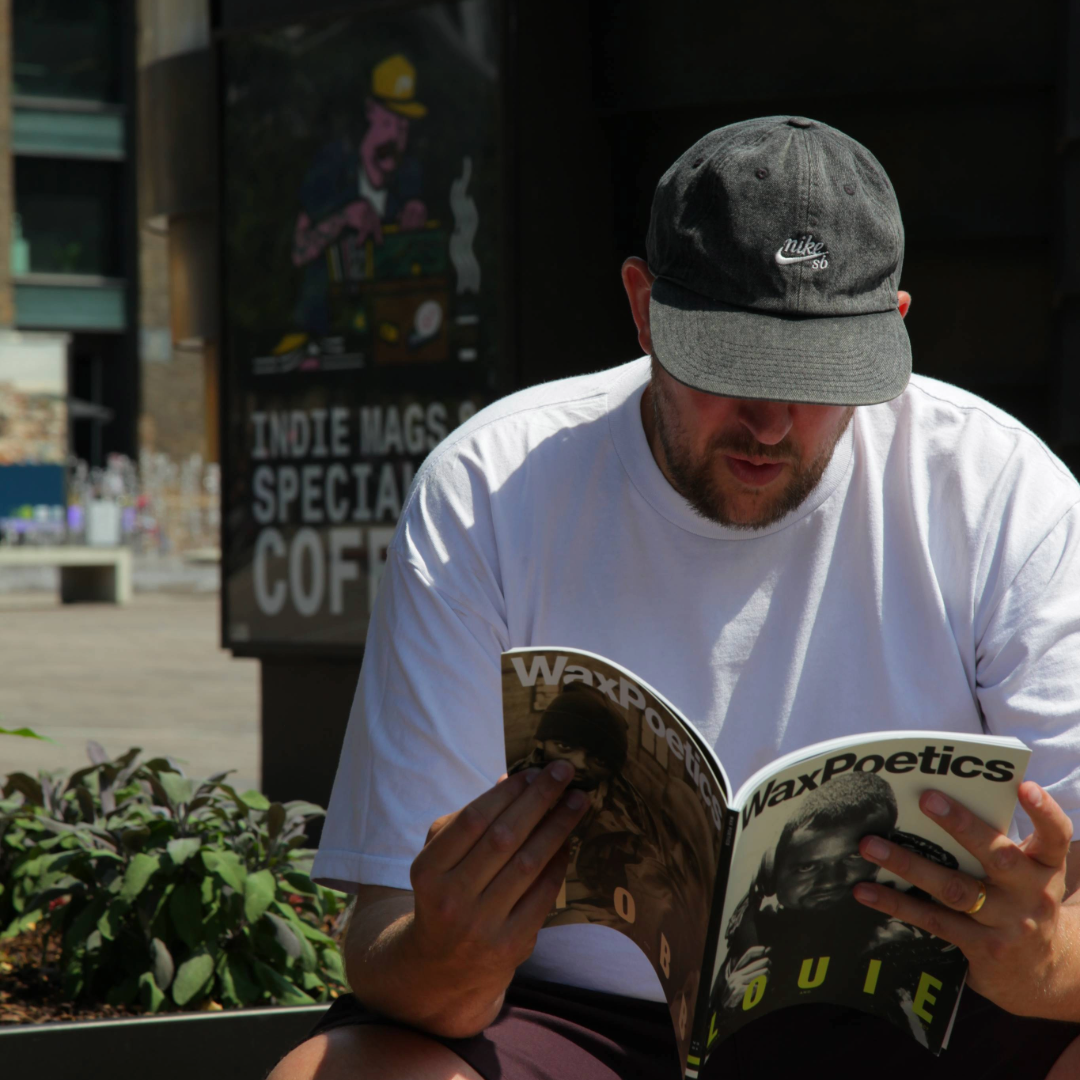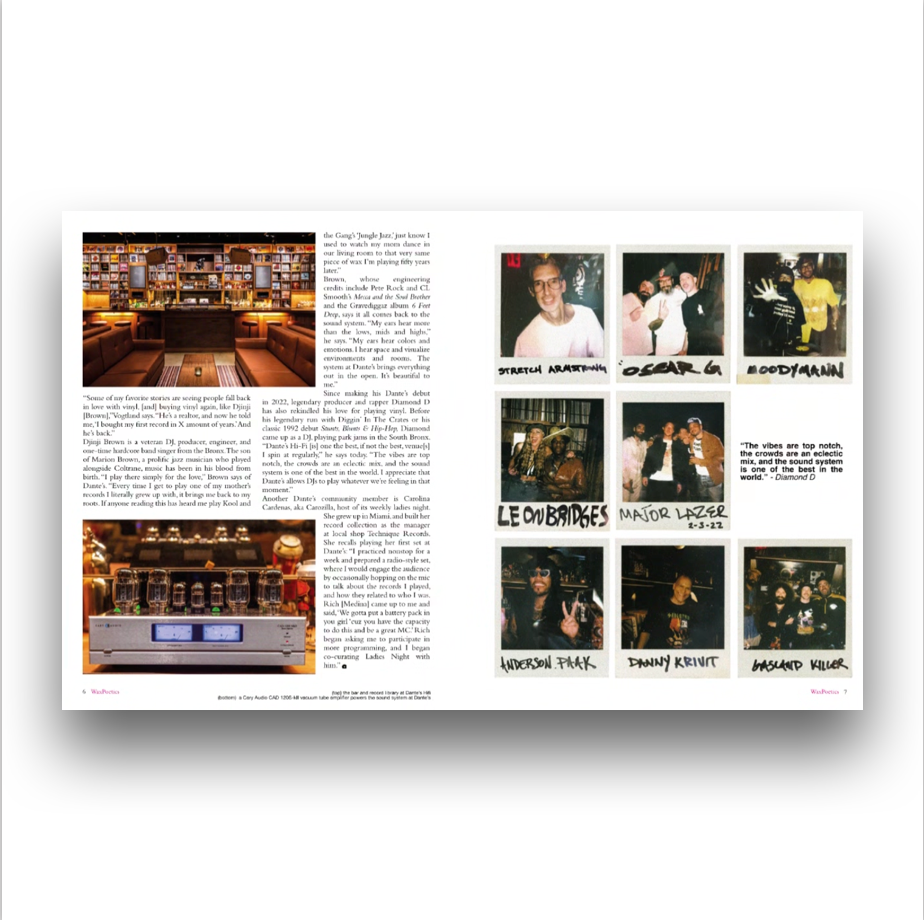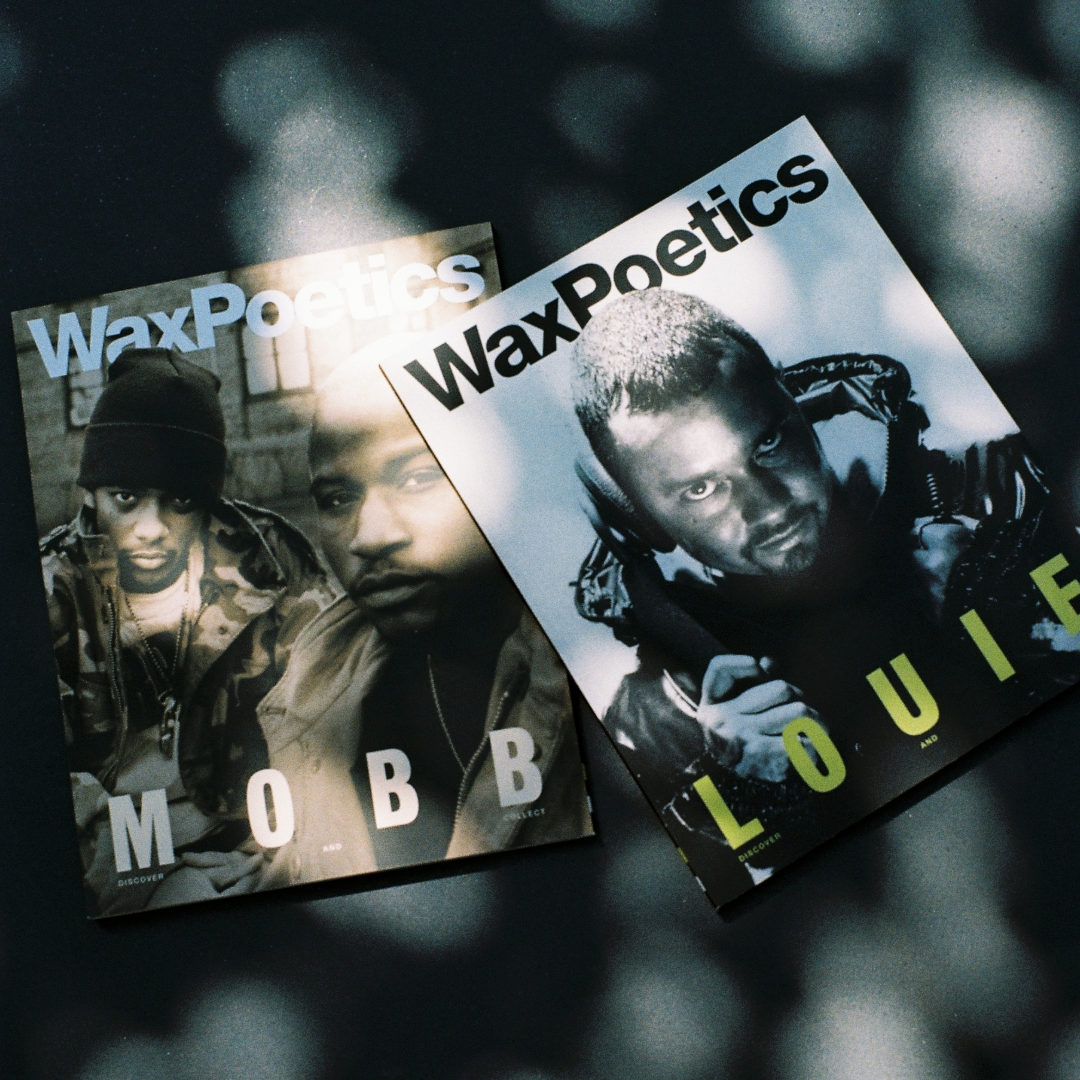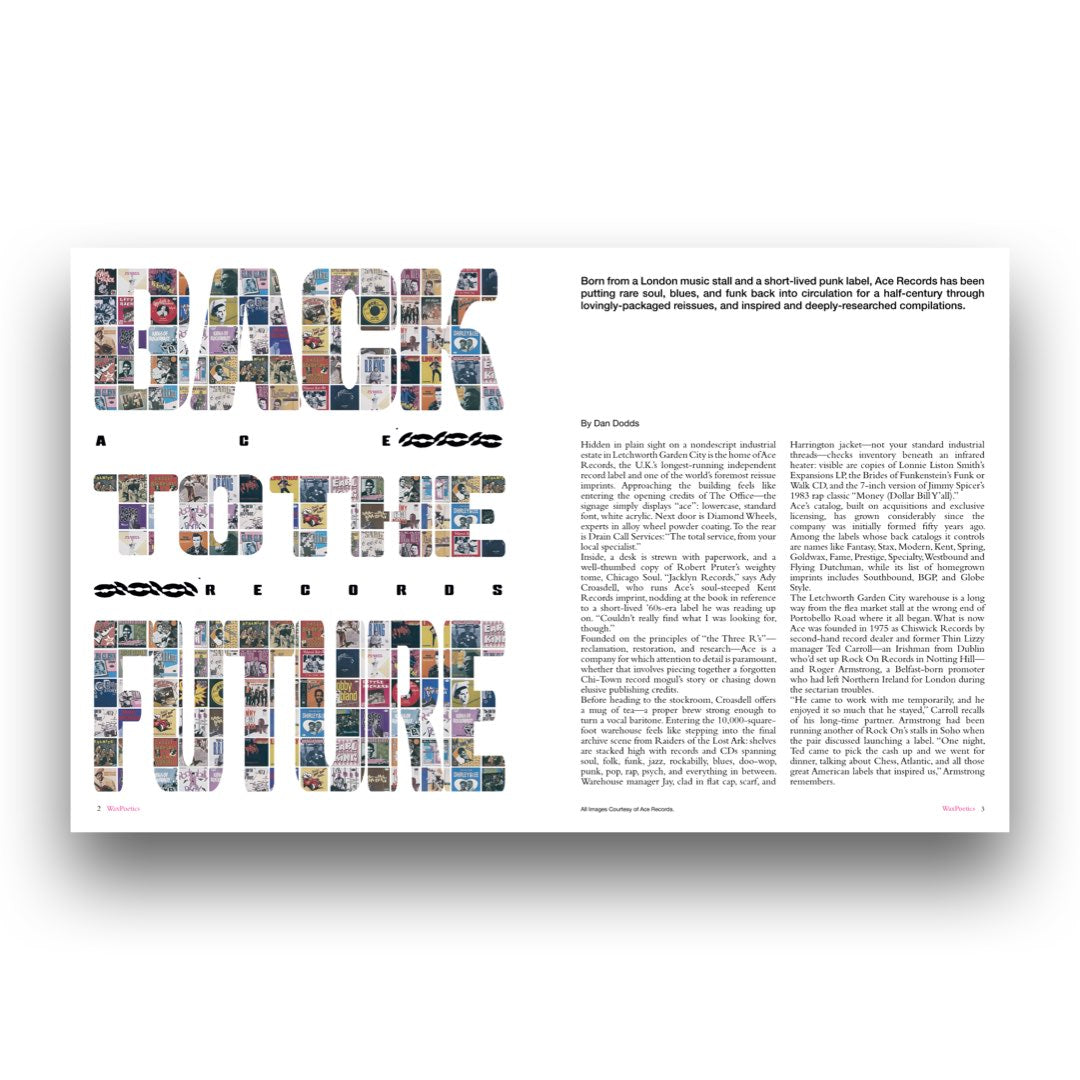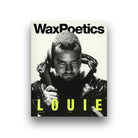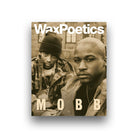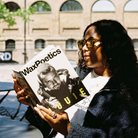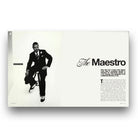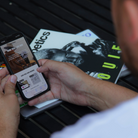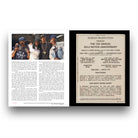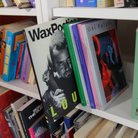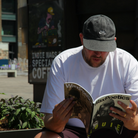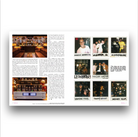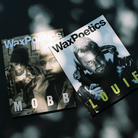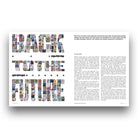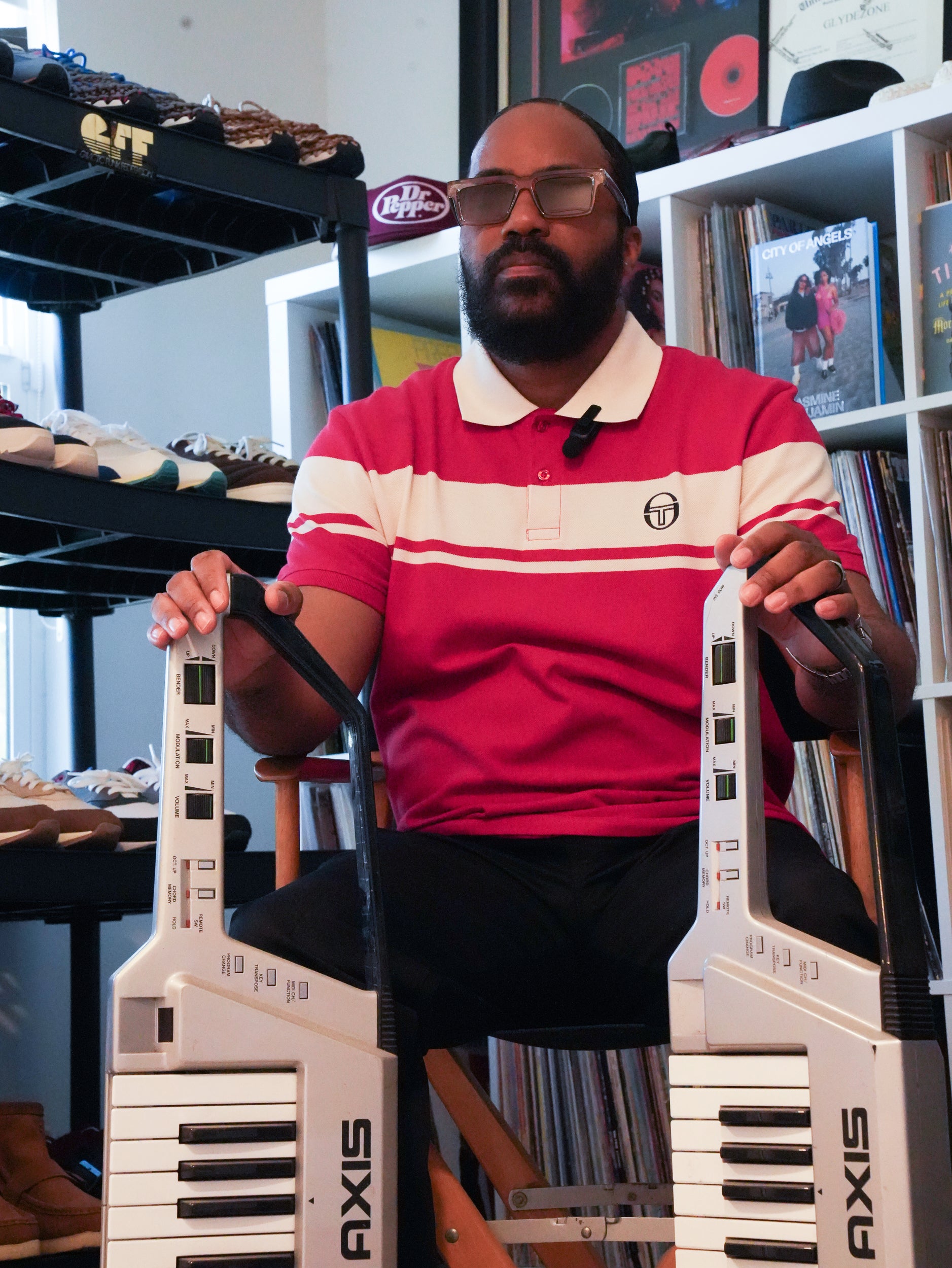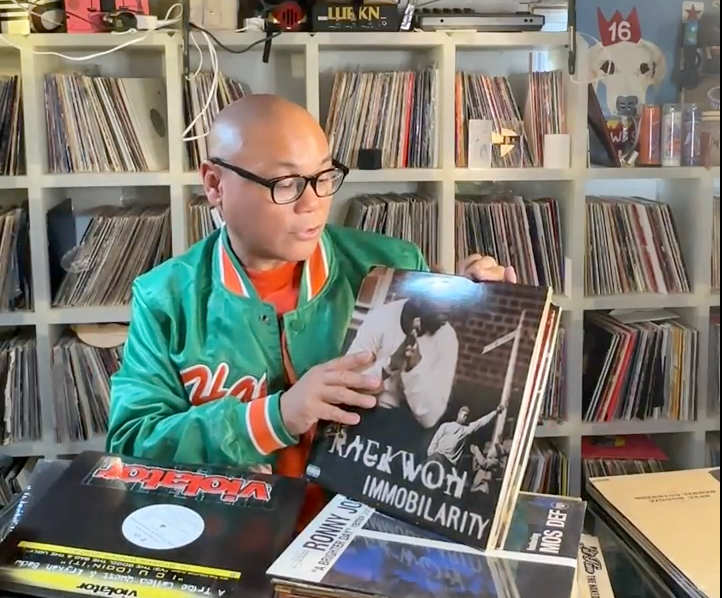THE TONY WILSON ARCHIVE COLLECTION
Following our Wax Poetics feature on Tony Wilson in New York, discover a capsule auction of originals, limited-edition prints and rare ephemera from the archive, plus an exclusive print made from an image featured in the article.
Stay up to date
twin cities
On a typewritten sheet of A4 paper, the itinerary for Joy Division’s planned first North American tour is hauntingly laid bare. Of course, none of it was to be: on May 18, 1980, the night before the Manchester group were to leave for New York, troubled singer Ian Curtis tragically took his life.
The first venue on the list, which we might presume was typed by the late Factory Records co-founder Tony Wilson himself, is the Midtown Manhattan club Hurrah. Just four months later, the remaining members of Joy Division would perform there in one of their first appearances as New Order, supporting fellow Factory Records act A Certain Ratio. Along with Danceteria, Paradise Garage, and the Fun House, Hurrah was to be a pivotal point in Factory’s deepening association with New York. Collectively these spaces, visited during tours by New Order, A Certain Ratio, and Quando Quango, would inspire Tony Wilson and New Order manager Rob Gretton to open the Haçienda, the Manchester nightclub that would revolutionize British clubbing. The sounds that the Factory acts encountered on New York dancefloors would also inform striking new directions in their own music.
Tony Wilson would later write about his early visits to these fantastical places in 24 Hour Party People: What the Sleeve Notes Never Tell You, a companion book to the 2002 feature film which starred Steve Coogan as Wilson in his Factory Records and Haçienda years. Describing Hurrah and Danceteria as “clubs as venue and disco and style lounge all in one” and “the kind of clubs that David Byrne could go to the toilet in,” he mused: “They were cool clubs. If New York had them, then why the fuck didn’t Manchester?”
The Joy Division tour note is one of many items in the Tony Wilson Archive, housed at the University of Manchester’s John Rylands Library, which offer a fascinating window into the connections between the city’s music scene and New York.
Alongside Xerox collages Wilson created for early events he organized with Alan Erasmus, with whom he co-founded Factory Records in 1978, are maps of Manhattan drawn by Wilson to pinpoint spots like Hurrah, hotel invoices covering telegrams back to Manchester, and correspondence between Michael Shamberg, who ran Factory Records’ New York office, and Wilson’s home address in Didsbury.
“My dad had a big thing for cities in both academic and philosophical ways, and New York was number one for him,” says Oliver Wilson, Tony Wilson’s son and archivist. “Back in the late ’70s and early ’80s, he saw many similarities between New York and Manchester. All those derelict warehouses in Manhattan would have reminded him of [Manchester industrial district] Ancoats, only on a larger scale. New York had a massive pull on my dad and it formed a big part on him. He would always tell me it was the most magnificent city in the world.”
In September 1980, New Order and ACR flew to New York accompanied by their respective managers Gretton and Wilson, alongside maverick producer Martin Hannett. As James Nice wrote in his book Shadowplayers: The Rise and Fall of Factory Records, “for everyone involved, the implications of this first Atlantic crossing would prove enormous.”
The plan was for the recently named New Order to support ACR at four U.S. shows, with the middle two occurring at Hurrah and a second Manhattan club, Tier 3, respectively. Time was booked at Eastern Artists Recording Studio [EARS] in nearby East Orange, New Jersey. There, with Hannett in the producer’s chair, New Order would record its first single “Ceremony” b/w “In a Lonely Place,” while ACR laid down tracks for its 1981 album, To Each.
Arriving in New York, the Manchester contingent connected with a woman who would be pivotal to their collective future, Ruth Polsky, an independent promoter who had booked the bands at Hurrah. “She was kind [of] queen of the New York club scene,” New Order’s Bernard Sumner wrote in his autobiography Chapter and Verse. “We’d go into Manhattan every night after being in the studio and she’d take us to New York’s best clubs: Danceteria, the Peppermint Lounge, the Mudd Club…wherever it might be happening that night.”
The crash course on New York nightlife would have an immediate and profound impact on New Order’s sound. “I remember quite clearly sitting in a club in New York one night around three or four in the morning and thinking how great it would be if we made music, electronic music, that could be played in some of these clubs,” Sumner recalled in Chapter and Verse.
Encamped in an unfurnished loft Wilson had rented for them on Hudson Street in Tribeca, the members of ACR found themselves exploring the city’s counter-cultural landscape in all of its variety. For the five young men of ACR—raised in 1970s industrial Northern England, where sticky-carpeted clubs predominated—design-forward, cross-cultural spaces like Hurrah and Danceteria offered sensory overload.
“Our heads just exploded when we got there,” recalls ACR guitarist and trumpeter Martin Moscrop. “U.K. clubs at the time didn’t have good sound systems or lighting. It was unheard of to have air conditioning. Then you went to New York and everything was well organized and set up right. They had amazing sound systems, great lighting. Everything was just on a different scale.”
Having been inducted into jazz funk, Latin, and Brazilian music by DJs Hewan Clarke, Colin Curtis, and John Grant at Manchester venues like Pips, Fever, and Rafters, the members of ACR were ecstatic to find an even more diverse mix of music in adventurous Manhattan clubs. “The music they were playing was really eclectic,” says Moscrop. “This mix of post-punk, electro, hip-hop, soul, and disco all thrown in together: That was a real inspiration to us.”
Hurrah, located at 36 West 62nd Street, had helped introduce New Yorkers to the emerging sounds of British new wave both with live bands and through DJs that included Anita Sarko, Sean Cassette, Sara Salir, Bill Bahlman, and Bart Dorsey. Videos were projected on monitors suspended above the dancefloor; Merrill Aldighieri coined the term “VJ” at the club to describe her role improvising a flow of film loops, live camera feeds, and other visuals to accompany and interpret the music played by the venue’s DJs.
Aldighieri, who recorded over two-hundred hours of performance footage at Hurrah between 1980 and 81, filmed both ACR and New Order’s sets there. ACR’s Hurrah performance was also captured in TriBeCa, a short film shot on 16mm monochrome stock by Baltimore native Michael Shamberg. Wilson and Shamberg struck up a quick friendship, and Shamberg, who would also become New Order’s longtime video producer and director, was tasked with opening Factory’s U.S. wing, dubbed Of Factory New York, on SoHo’s Spring Street in May 1981. “When Factory first went to America, the whole thing was characterized by Michael Shamberg. Very much a kind of art, leftfield take on New York,” Factory’s artistic director Peter Saville told James Nice in the liner notes to Of Factory New York, a 2014 benefit album for Shamberg, who died that year following a long illness.
Also staffing the office was Anne Lehman, who had met Tony Wilson while working for Rough Trade Records in San Francisco. “He was so incredibly open and I thought he was brilliant,” she told Audrey Golden in her book I Thought I Heard You Speak: Women at Factory Records. “I was just a kid, twenty-two or something, but I felt really respected by him.” This was typical of Wilson’s supportive attitude towards young people, whether taking the unruly genius of the Happy Mondays into the Factory fold, or creating the Haçienda for the youth of Manchester.
On arrival from California, Lehman quickly found herself in the eye of the Factory storm. “The Factory office was in the old Port Authority trucking building. It was gorgeous [but] the office was a mess when I got there,” she told Golden. “I created files for all the stuff because Michael could never find anything…I felt like I might be contributing to something. I was just looking at the Factory stationary that had my name on it. I remember when that happened I felt like, ‘Wow, I’m getting some recognition’.”
Another presence at the New York office was Miranda Stanton, Michael Shamberg’s partner at the time. Along with arranger Carter Burwell, she comprised one half of art-pop duo Thick Pigeon, whose Too Crazy Cowboys, recorded in Manchester with Stephen Morris and Gillian Gilbert of New Order producing, would be issued by Factory in 1984. As Stanton Miranda, she also released the 1986 single “Wheels Over Indian Trails” on the label, and provided guest vocals on Durutti Column’s The Guitar and Other Machines.
Tony Wilson, for his part, chose to do much of his business from a diner on Spring Street. “This was like his unofficial office,” says Oli Wilson. “There was a payphone in the corner, and he always used to say, ‘All you need is a payphone and a pencil and paper.’”
Like what you're reading? Get our summer 2025 COLLECTORS issue.
In addition to playing Hurrah on that first trip in 1980, ACR and New Order performed at a small Tribeca club located a few blocks from the loft that Tony Wilson had rented for ACR. “What I actually remember most about the first trip to New York was playing Tier 3,” says Moscrop. “A lot of the clubs were big, but Tier 3 was tiny. The audience was right on top of you and the energy in there was incredible.”
The Tier 3 show proved inspirational not only for ACR (who named a track after it on their 2023 album 1982) but also some of its attendees, which included a teenaged Mike D and Ad-Rock, who recalled the night in 2018’s Beastie Boys Book, as well as Matt Dike, future co-founder of Delicious Vinyl.
Opened by twenty-three-year-old Hilary Jaeger in Spring 1979, Tier 3 was among the first Manhattan clubs to mix experimental music, film, and art. Although it only lasted until December 1980, its downtown credentials were sealed when Jean-Michel Basquiat painted a mural in the bar before appearing there as a DJ and with his band, Grey. Staging gigs by Lounge Lizards, Bush Tetras, and DNA, it was an important home for no-wave next to the better known Mudd Club. And, like Hurrah, it had hosted early U.S. gigs by U.K. post-punk and new-wave outfits, including the Pop Group, the Raincoats, the Slits, and Young Marble Giants.
Of all the clubs they visited on that first trip in 1980, it was Danceteria that would make the deepest impression on Tony Wilson and the Factory entourage. Jim Fouratt, formerly a manager at Hurrah, opened Danceteria with Rudolf Piper on West 37th Street in May 1980, relocating the club two years later to its more successful second location at 30 West 21st Street. “Hurrah was the incubator but, because it had one floor, it was limited to linear movement,” Fouratt told Tim Lawrence in 2016’s Life and Death of the New York Dancefloor. “Having three floors on 37th Street changed everything. The DJs weren’t in competition with the bands and the video lounge…the mix of art, live music, video, fashion, staff, and DJing was the formula.”
Danceteria offered an immersive, cross-artistic club experience unlike anything the Mancunian contingent had seen. “I think, out of all the clubs, Danceteria was the one that the Haçienda would become based on, and that was a well-designed club on three levels with great sound and lights with lots of different things going on,” says Martin Moscrop. ACR would play Danceteria on December 16 and 17, 1982, with support on the first night by a young Madonna.
The club’s original DJs were Sean Cassette, from the Mudd Club and Hurrah, and Mark Kamins, who Fouratt had seen spin at Trax on 72nd Street. Joining the dots between post-punk, new wave, mutant disco, dub, and electro, Kamins would have a huge impact on the Factory entourage. A young Mike Pickering, who would go on to DJ at seminal Haçienda club nights Nude and Hot, visited the West 21st Street location on his first visit to New York as a member of the band Quando Quango in 1982. “Mark and I bonded immediately and began a wonderful friendship that lasted until his death [in 2013],” he says.
Ruth Polsky captured the wild diversity of Danceteria in a 1983 interview with Channel 4’s The Tube. “This is a place where anything goes—from oompah bands to Diamanda Galás [to] the funkiest thing happening on the street. We try to do as much variety as possible and to present music from all over the world.” That could be anything from Sun Ra to Tito Puente and all points between and beyond.
As a booker at Hurrah and, later, Danceteria, Polsky was central to the success of the Factory bands in America. She tragically died in 1986 when she was hit by a runaway taxi outside another iconic New York club, the Limelight, but left a lasting legacy. “Ruth Polsky was an integral player in the American success of many bands from England and particularly bands from Manchester,” New York journalist Rachel Felder told Audrey Golden in I Thought I Heard You Speak. “The fees she was able to pay at the clubs she booked enabled those bands to tour America. Even if a band played just one night in a tiny venue in New York City, it reverberated in the U.K. and beyond.”
During her time at Hurrah, Polsky had fortuitously booked ACR on the same bill with a group of Bronx sisters who were then building a buzz on the Manhattan club scene. Named after their birthstones—Emerald, Sapphire, and Gold—by a mother who bought instruments to keep her daughters away from the borough’s harsh streets, ESG were one of the most influential bands of New York’s post-punk no-wave scene, spiritual cousins to their 99 Records labelmates Liquid Liquid. Having soaked up what singer Renee Scroggins called the “savage drive” of beats from their Bronx neighborhood, the band produced a naïve but acutely funky sound all their own.
Tony Wilson was so impressed by the pure and primal sound of ESG that he invited them to record at EARS after ACR finished their sessions. “I had no idea who Tony Wilson was,” Renee Scroggins recalls. “But he was watching our soundcheck and, afterwards, he came up and said, ‘I really like what you are doing, how would you like to make a record?’ I didn’t take him seriously because we had been bugging [99 Records label head] Ed Bahlman for two years about releasing us. So I will always give credit to Tony Wilson and Factory Records.”
The session brought the Scroggins sisters into the studio with the famously mercurial Martin Hannett. “Everyone talks about him and I’ve seen the movie 24 Hour Party People but this was not the guy that I met,” says Renee. “The guy that I met was calm, respectful. I had no idea he was this big important producer, because he was just a cool guy. He took me in and showed me around the mixing boards and, after we’d record something, he’d ask if I liked it.”
The three tracks ESG recorded at EARS—“Moody,” “UFO,” and “You’re No Good”— would become their signature tunes, brilliant slabs of ominous, minimal funk, later heavily sampled in hip-hop. It was a sound Wilson described as “PiL meets Motown on the wrong side of the Triboro Bridge.” The EARS recordings, released on seven-inch as FAC 41 in April 1981, were the first by a New York act to be released on Factory Records.
After completing their sessions, meanwhile, the members of ACR soaked up the Latin scene in the city. “Going to Central Park and hearing all the Cuban rumba players jamming was a real eye opener,” says Martin Moscrop. “We went to see a gig by Dave Valentin with him coming out of the dressing room with his band, snaking through the audience playing Latin percussion. That blew us away.”
The sounds of Latin music weren’t new to ACR but to hear it at its source added an exciting new dimension. “To go to New York and [be] around that culture, that fused into everything we did and just set us off in a new direction,” adds drummer Donald Johnson. Near where the studio in New Jersey was the home of Latin Percussion, renowned makers of congas, timbales, and the like; a productive visit to its shop with Tony Wilson would be another gamechanger for the band. “In Manchester, we couldn’t even find a [Latin Percussion] section in a music shop,” Johnson says.
continued in our summer issue...
Don't miss our upcoming collections
We have so much more coming. Sign-up to any of the below to make sure you don't miss out.
